Effectiveness of Financial Statement
VerifiedAdded on 2021/06/16
|21
|2452
|19
AI Summary
Contribute Materials
Your contribution can guide someone’s learning journey. Share your
documents today.
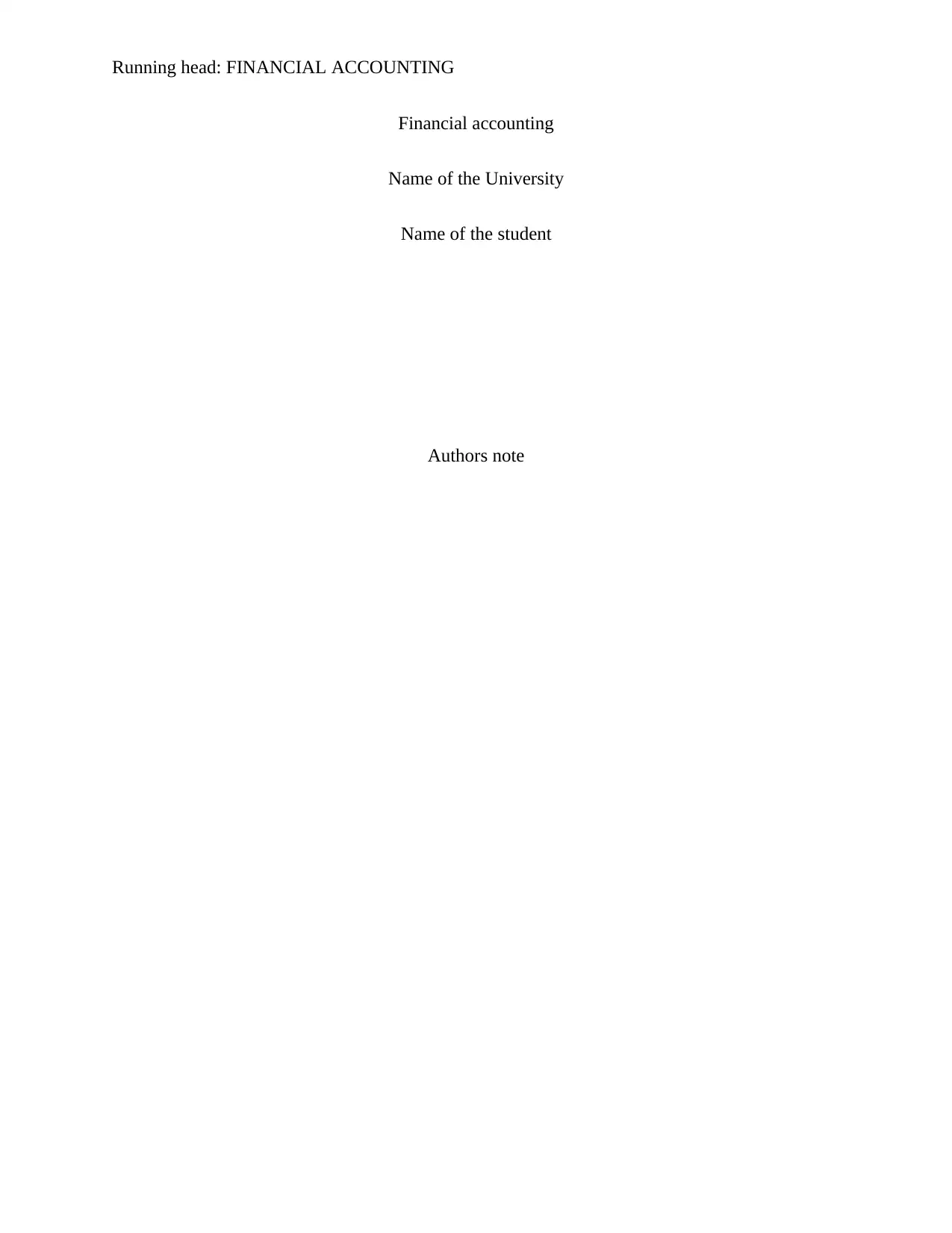
Running head: FINANCIAL ACCOUNTING
Financial accounting
Name of the University
Name of the student
Authors note
Financial accounting
Name of the University
Name of the student
Authors note
Secure Best Marks with AI Grader
Need help grading? Try our AI Grader for instant feedback on your assignments.
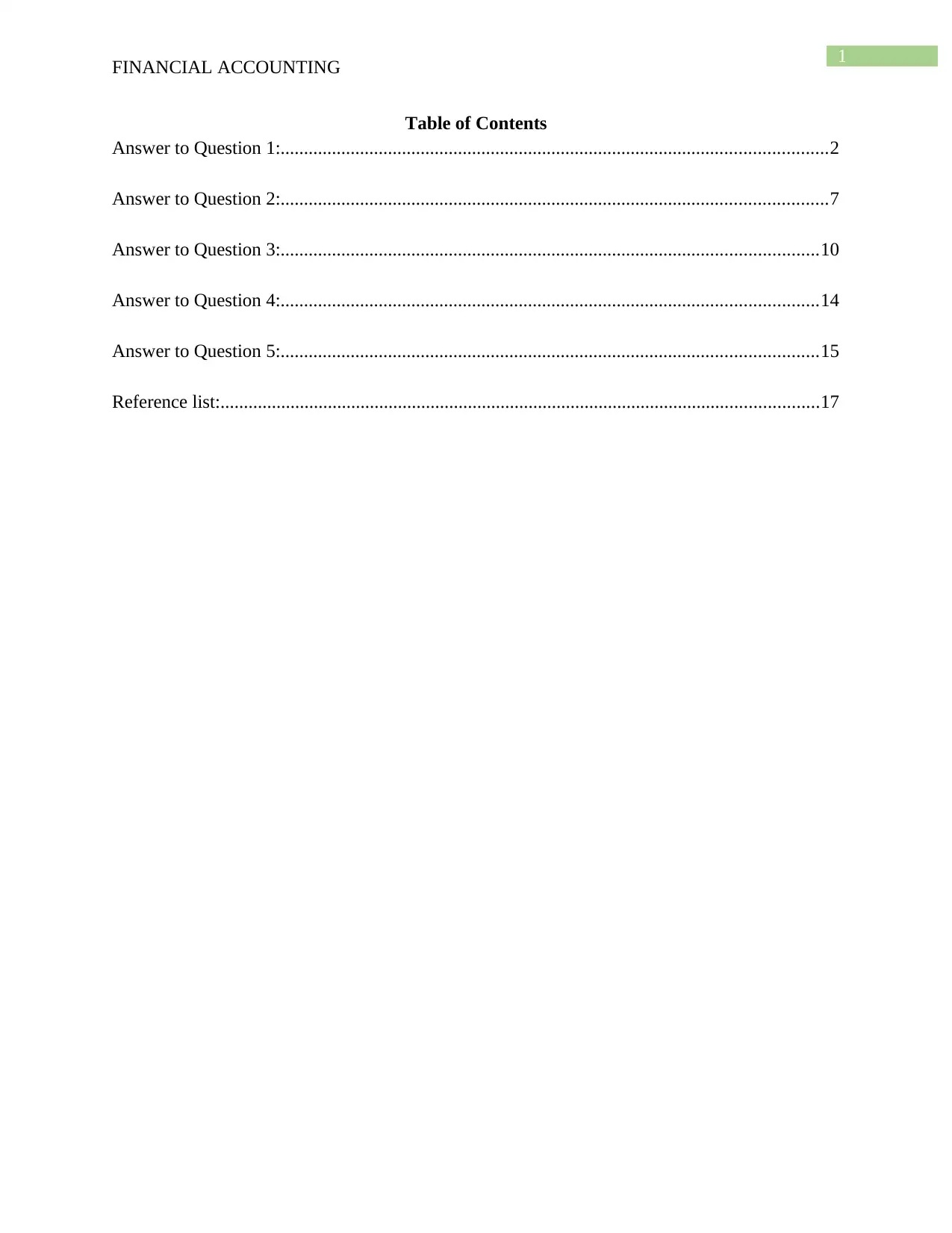
1
FINANCIAL ACCOUNTING
Table of Contents
Answer to Question 1:.....................................................................................................................2
Answer to Question 2:.....................................................................................................................7
Answer to Question 3:...................................................................................................................10
Answer to Question 4:...................................................................................................................14
Answer to Question 5:...................................................................................................................15
Reference list:................................................................................................................................17
FINANCIAL ACCOUNTING
Table of Contents
Answer to Question 1:.....................................................................................................................2
Answer to Question 2:.....................................................................................................................7
Answer to Question 3:...................................................................................................................10
Answer to Question 4:...................................................................................................................14
Answer to Question 5:...................................................................................................................15
Reference list:................................................................................................................................17
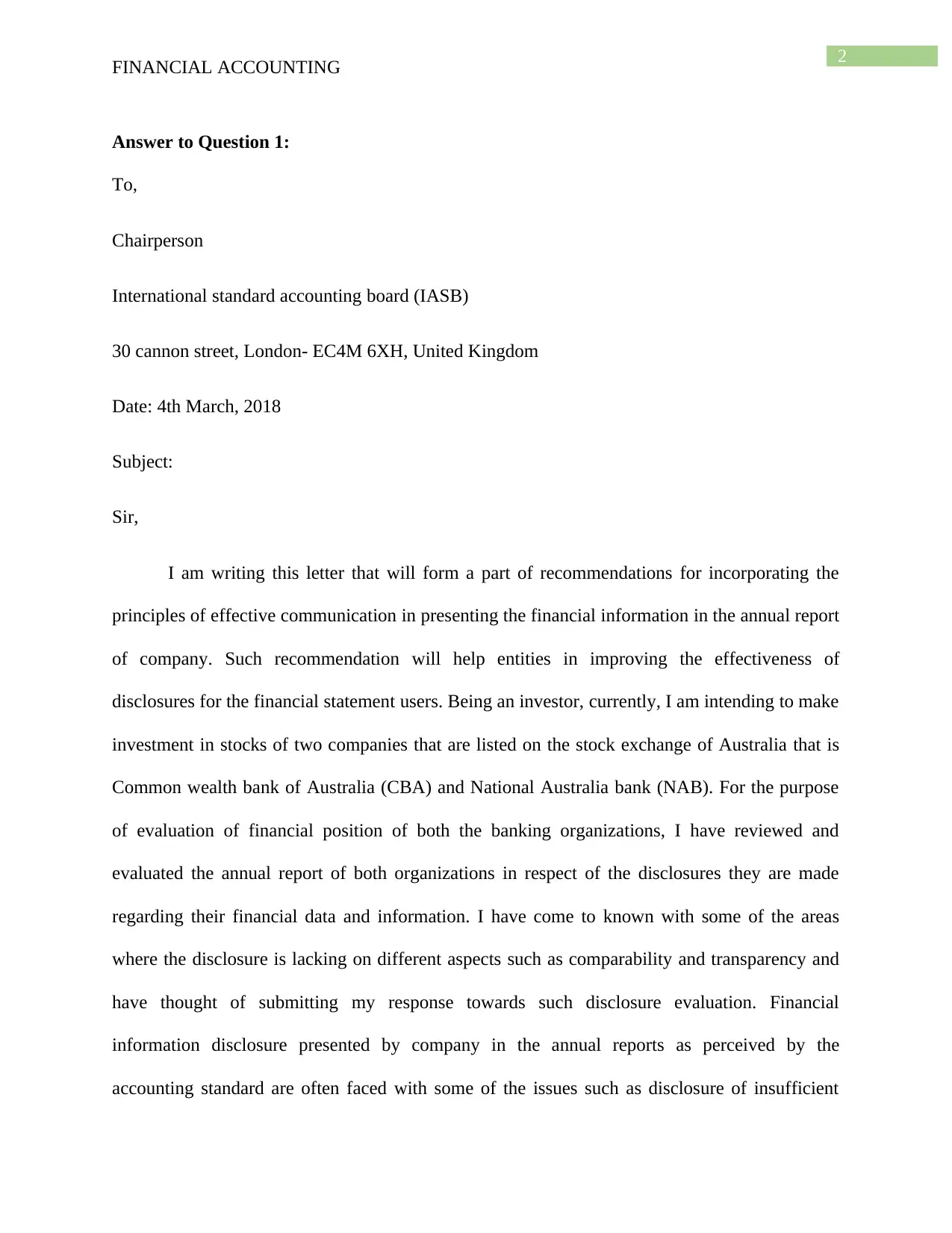
2
FINANCIAL ACCOUNTING
Answer to Question 1:
To,
Chairperson
International standard accounting board (IASB)
30 cannon street, London- EC4M 6XH, United Kingdom
Date: 4th March, 2018
Subject:
Sir,
I am writing this letter that will form a part of recommendations for incorporating the
principles of effective communication in presenting the financial information in the annual report
of company. Such recommendation will help entities in improving the effectiveness of
disclosures for the financial statement users. Being an investor, currently, I am intending to make
investment in stocks of two companies that are listed on the stock exchange of Australia that is
Common wealth bank of Australia (CBA) and National Australia bank (NAB). For the purpose
of evaluation of financial position of both the banking organizations, I have reviewed and
evaluated the annual report of both organizations in respect of the disclosures they are made
regarding their financial data and information. I have come to known with some of the areas
where the disclosure is lacking on different aspects such as comparability and transparency and
have thought of submitting my response towards such disclosure evaluation. Financial
information disclosure presented by company in the annual reports as perceived by the
accounting standard are often faced with some of the issues such as disclosure of insufficient
FINANCIAL ACCOUNTING
Answer to Question 1:
To,
Chairperson
International standard accounting board (IASB)
30 cannon street, London- EC4M 6XH, United Kingdom
Date: 4th March, 2018
Subject:
Sir,
I am writing this letter that will form a part of recommendations for incorporating the
principles of effective communication in presenting the financial information in the annual report
of company. Such recommendation will help entities in improving the effectiveness of
disclosures for the financial statement users. Being an investor, currently, I am intending to make
investment in stocks of two companies that are listed on the stock exchange of Australia that is
Common wealth bank of Australia (CBA) and National Australia bank (NAB). For the purpose
of evaluation of financial position of both the banking organizations, I have reviewed and
evaluated the annual report of both organizations in respect of the disclosures they are made
regarding their financial data and information. I have come to known with some of the areas
where the disclosure is lacking on different aspects such as comparability and transparency and
have thought of submitting my response towards such disclosure evaluation. Financial
information disclosure presented by company in the annual reports as perceived by the
accounting standard are often faced with some of the issues such as disclosure of insufficient
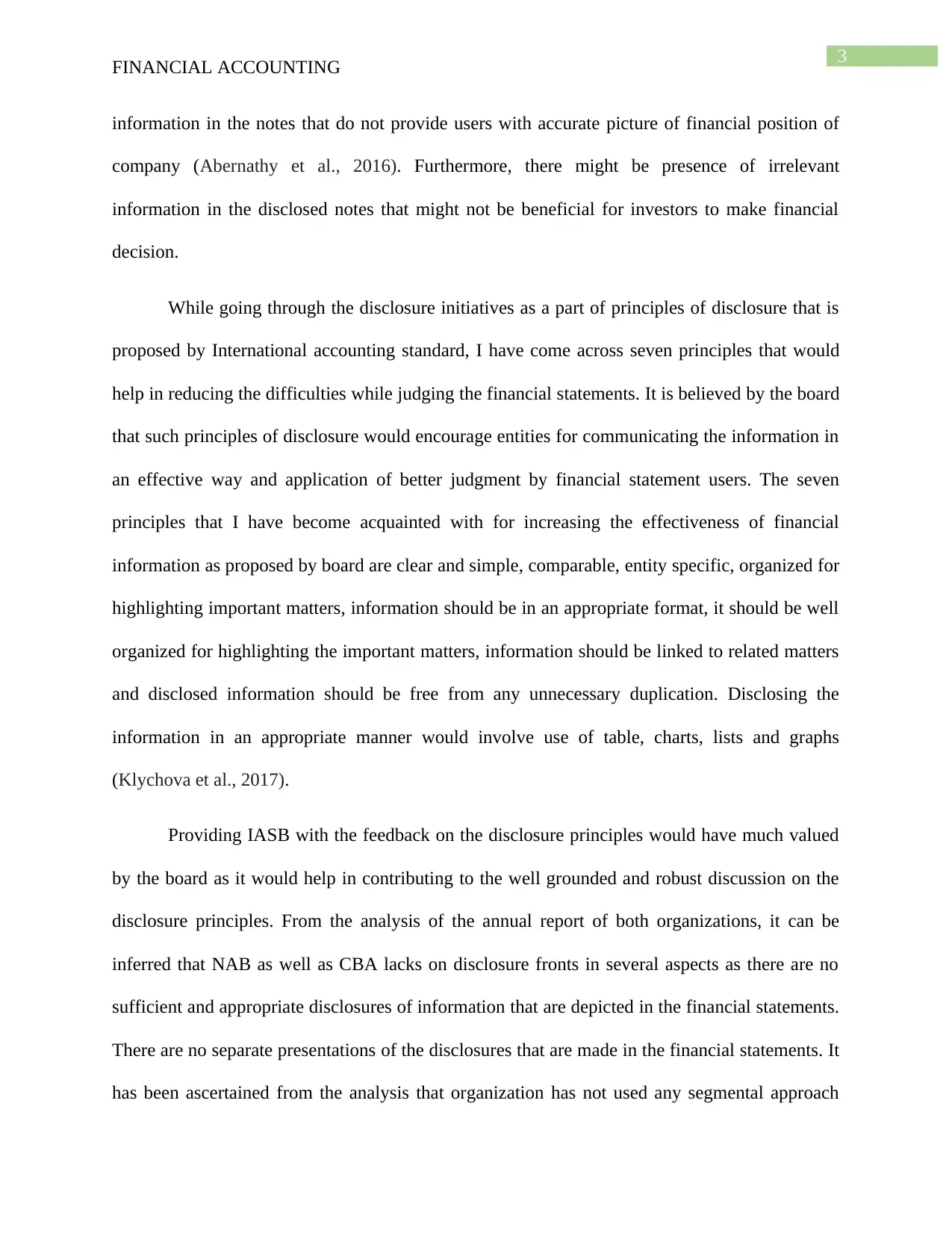
3
FINANCIAL ACCOUNTING
information in the notes that do not provide users with accurate picture of financial position of
company (Abernathy et al., 2016). Furthermore, there might be presence of irrelevant
information in the disclosed notes that might not be beneficial for investors to make financial
decision.
While going through the disclosure initiatives as a part of principles of disclosure that is
proposed by International accounting standard, I have come across seven principles that would
help in reducing the difficulties while judging the financial statements. It is believed by the board
that such principles of disclosure would encourage entities for communicating the information in
an effective way and application of better judgment by financial statement users. The seven
principles that I have become acquainted with for increasing the effectiveness of financial
information as proposed by board are clear and simple, comparable, entity specific, organized for
highlighting important matters, information should be in an appropriate format, it should be well
organized for highlighting the important matters, information should be linked to related matters
and disclosed information should be free from any unnecessary duplication. Disclosing the
information in an appropriate manner would involve use of table, charts, lists and graphs
(Klychova et al., 2017).
Providing IASB with the feedback on the disclosure principles would have much valued
by the board as it would help in contributing to the well grounded and robust discussion on the
disclosure principles. From the analysis of the annual report of both organizations, it can be
inferred that NAB as well as CBA lacks on disclosure fronts in several aspects as there are no
sufficient and appropriate disclosures of information that are depicted in the financial statements.
There are no separate presentations of the disclosures that are made in the financial statements. It
has been ascertained from the analysis that organization has not used any segmental approach
FINANCIAL ACCOUNTING
information in the notes that do not provide users with accurate picture of financial position of
company (Abernathy et al., 2016). Furthermore, there might be presence of irrelevant
information in the disclosed notes that might not be beneficial for investors to make financial
decision.
While going through the disclosure initiatives as a part of principles of disclosure that is
proposed by International accounting standard, I have come across seven principles that would
help in reducing the difficulties while judging the financial statements. It is believed by the board
that such principles of disclosure would encourage entities for communicating the information in
an effective way and application of better judgment by financial statement users. The seven
principles that I have become acquainted with for increasing the effectiveness of financial
information as proposed by board are clear and simple, comparable, entity specific, organized for
highlighting important matters, information should be in an appropriate format, it should be well
organized for highlighting the important matters, information should be linked to related matters
and disclosed information should be free from any unnecessary duplication. Disclosing the
information in an appropriate manner would involve use of table, charts, lists and graphs
(Klychova et al., 2017).
Providing IASB with the feedback on the disclosure principles would have much valued
by the board as it would help in contributing to the well grounded and robust discussion on the
disclosure principles. From the analysis of the annual report of both organizations, it can be
inferred that NAB as well as CBA lacks on disclosure fronts in several aspects as there are no
sufficient and appropriate disclosures of information that are depicted in the financial statements.
There are no separate presentations of the disclosures that are made in the financial statements. It
has been ascertained from the analysis that organization has not used any segmental approach
Secure Best Marks with AI Grader
Need help grading? Try our AI Grader for instant feedback on your assignments.
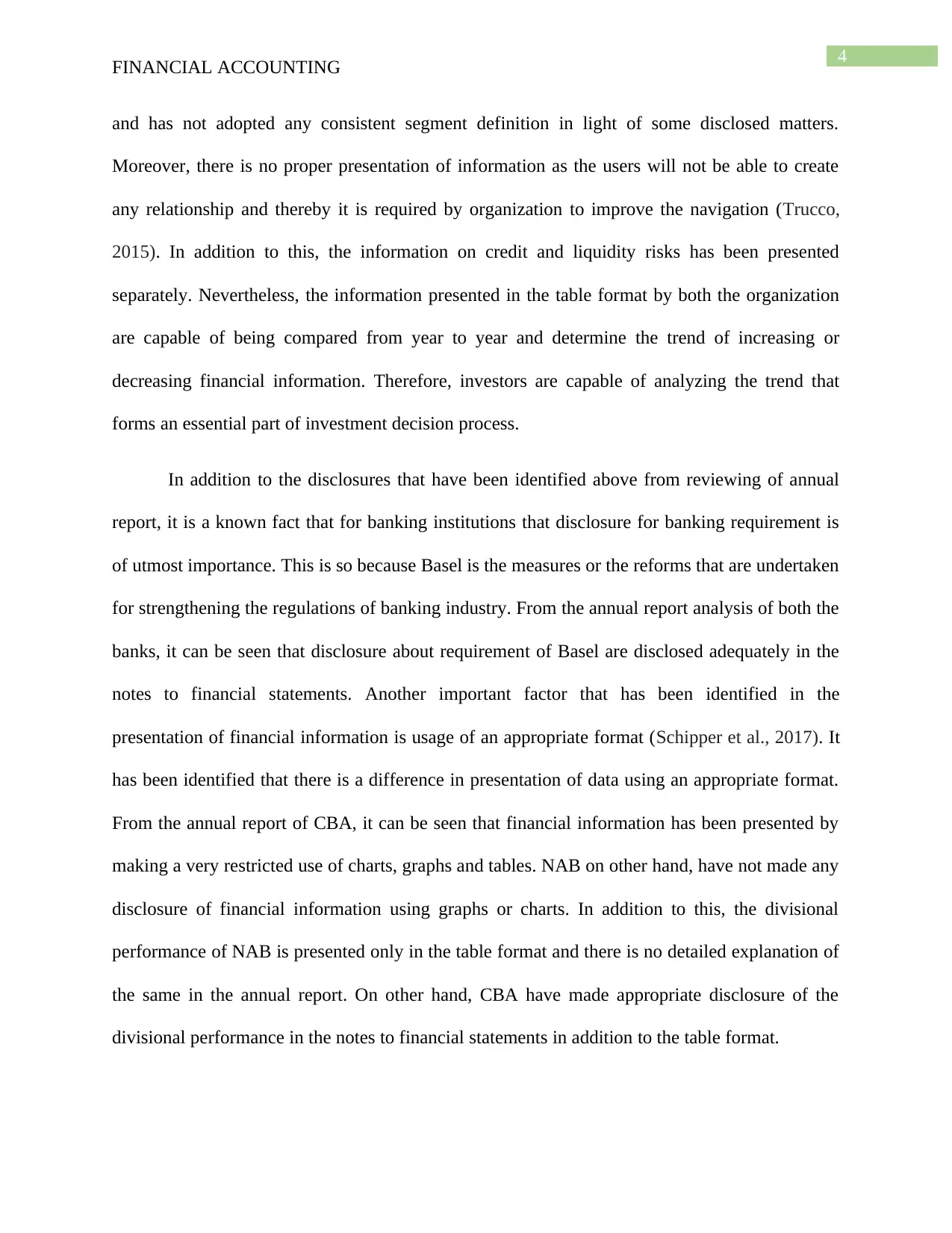
4
FINANCIAL ACCOUNTING
and has not adopted any consistent segment definition in light of some disclosed matters.
Moreover, there is no proper presentation of information as the users will not be able to create
any relationship and thereby it is required by organization to improve the navigation (Trucco,
2015). In addition to this, the information on credit and liquidity risks has been presented
separately. Nevertheless, the information presented in the table format by both the organization
are capable of being compared from year to year and determine the trend of increasing or
decreasing financial information. Therefore, investors are capable of analyzing the trend that
forms an essential part of investment decision process.
In addition to the disclosures that have been identified above from reviewing of annual
report, it is a known fact that for banking institutions that disclosure for banking requirement is
of utmost importance. This is so because Basel is the measures or the reforms that are undertaken
for strengthening the regulations of banking industry. From the annual report analysis of both the
banks, it can be seen that disclosure about requirement of Basel are disclosed adequately in the
notes to financial statements. Another important factor that has been identified in the
presentation of financial information is usage of an appropriate format (Schipper et al., 2017). It
has been identified that there is a difference in presentation of data using an appropriate format.
From the annual report of CBA, it can be seen that financial information has been presented by
making a very restricted use of charts, graphs and tables. NAB on other hand, have not made any
disclosure of financial information using graphs or charts. In addition to this, the divisional
performance of NAB is presented only in the table format and there is no detailed explanation of
the same in the annual report. On other hand, CBA have made appropriate disclosure of the
divisional performance in the notes to financial statements in addition to the table format.
FINANCIAL ACCOUNTING
and has not adopted any consistent segment definition in light of some disclosed matters.
Moreover, there is no proper presentation of information as the users will not be able to create
any relationship and thereby it is required by organization to improve the navigation (Trucco,
2015). In addition to this, the information on credit and liquidity risks has been presented
separately. Nevertheless, the information presented in the table format by both the organization
are capable of being compared from year to year and determine the trend of increasing or
decreasing financial information. Therefore, investors are capable of analyzing the trend that
forms an essential part of investment decision process.
In addition to the disclosures that have been identified above from reviewing of annual
report, it is a known fact that for banking institutions that disclosure for banking requirement is
of utmost importance. This is so because Basel is the measures or the reforms that are undertaken
for strengthening the regulations of banking industry. From the annual report analysis of both the
banks, it can be seen that disclosure about requirement of Basel are disclosed adequately in the
notes to financial statements. Another important factor that has been identified in the
presentation of financial information is usage of an appropriate format (Schipper et al., 2017). It
has been identified that there is a difference in presentation of data using an appropriate format.
From the annual report of CBA, it can be seen that financial information has been presented by
making a very restricted use of charts, graphs and tables. NAB on other hand, have not made any
disclosure of financial information using graphs or charts. In addition to this, the divisional
performance of NAB is presented only in the table format and there is no detailed explanation of
the same in the annual report. On other hand, CBA have made appropriate disclosure of the
divisional performance in the notes to financial statements in addition to the table format.
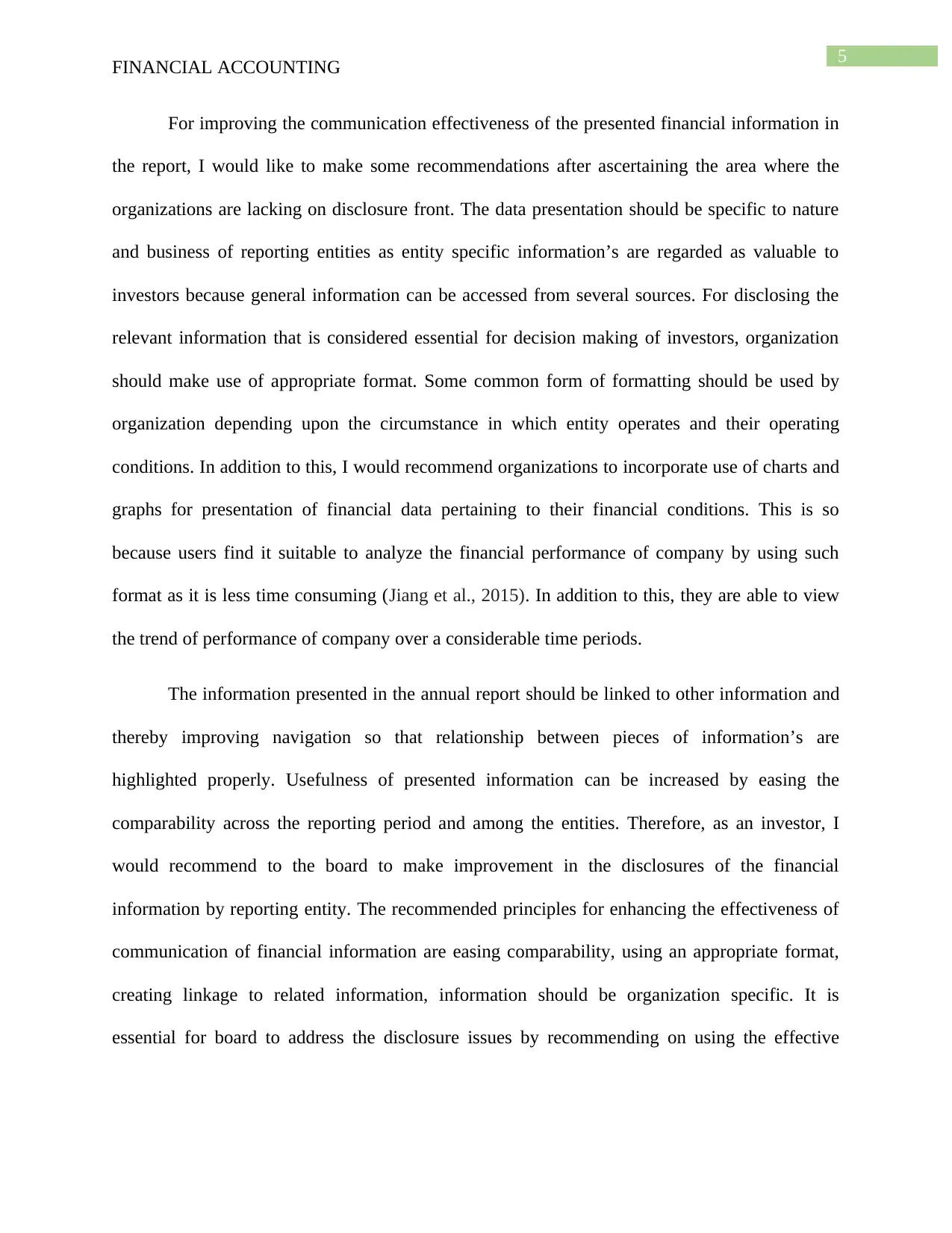
5
FINANCIAL ACCOUNTING
For improving the communication effectiveness of the presented financial information in
the report, I would like to make some recommendations after ascertaining the area where the
organizations are lacking on disclosure front. The data presentation should be specific to nature
and business of reporting entities as entity specific information’s are regarded as valuable to
investors because general information can be accessed from several sources. For disclosing the
relevant information that is considered essential for decision making of investors, organization
should make use of appropriate format. Some common form of formatting should be used by
organization depending upon the circumstance in which entity operates and their operating
conditions. In addition to this, I would recommend organizations to incorporate use of charts and
graphs for presentation of financial data pertaining to their financial conditions. This is so
because users find it suitable to analyze the financial performance of company by using such
format as it is less time consuming (Jiang et al., 2015). In addition to this, they are able to view
the trend of performance of company over a considerable time periods.
The information presented in the annual report should be linked to other information and
thereby improving navigation so that relationship between pieces of information’s are
highlighted properly. Usefulness of presented information can be increased by easing the
comparability across the reporting period and among the entities. Therefore, as an investor, I
would recommend to the board to make improvement in the disclosures of the financial
information by reporting entity. The recommended principles for enhancing the effectiveness of
communication of financial information are easing comparability, using an appropriate format,
creating linkage to related information, information should be organization specific. It is
essential for board to address the disclosure issues by recommending on using the effective
FINANCIAL ACCOUNTING
For improving the communication effectiveness of the presented financial information in
the report, I would like to make some recommendations after ascertaining the area where the
organizations are lacking on disclosure front. The data presentation should be specific to nature
and business of reporting entities as entity specific information’s are regarded as valuable to
investors because general information can be accessed from several sources. For disclosing the
relevant information that is considered essential for decision making of investors, organization
should make use of appropriate format. Some common form of formatting should be used by
organization depending upon the circumstance in which entity operates and their operating
conditions. In addition to this, I would recommend organizations to incorporate use of charts and
graphs for presentation of financial data pertaining to their financial conditions. This is so
because users find it suitable to analyze the financial performance of company by using such
format as it is less time consuming (Jiang et al., 2015). In addition to this, they are able to view
the trend of performance of company over a considerable time periods.
The information presented in the annual report should be linked to other information and
thereby improving navigation so that relationship between pieces of information’s are
highlighted properly. Usefulness of presented information can be increased by easing the
comparability across the reporting period and among the entities. Therefore, as an investor, I
would recommend to the board to make improvement in the disclosures of the financial
information by reporting entity. The recommended principles for enhancing the effectiveness of
communication of financial information are easing comparability, using an appropriate format,
creating linkage to related information, information should be organization specific. It is
essential for board to address the disclosure issues by recommending on using the effective
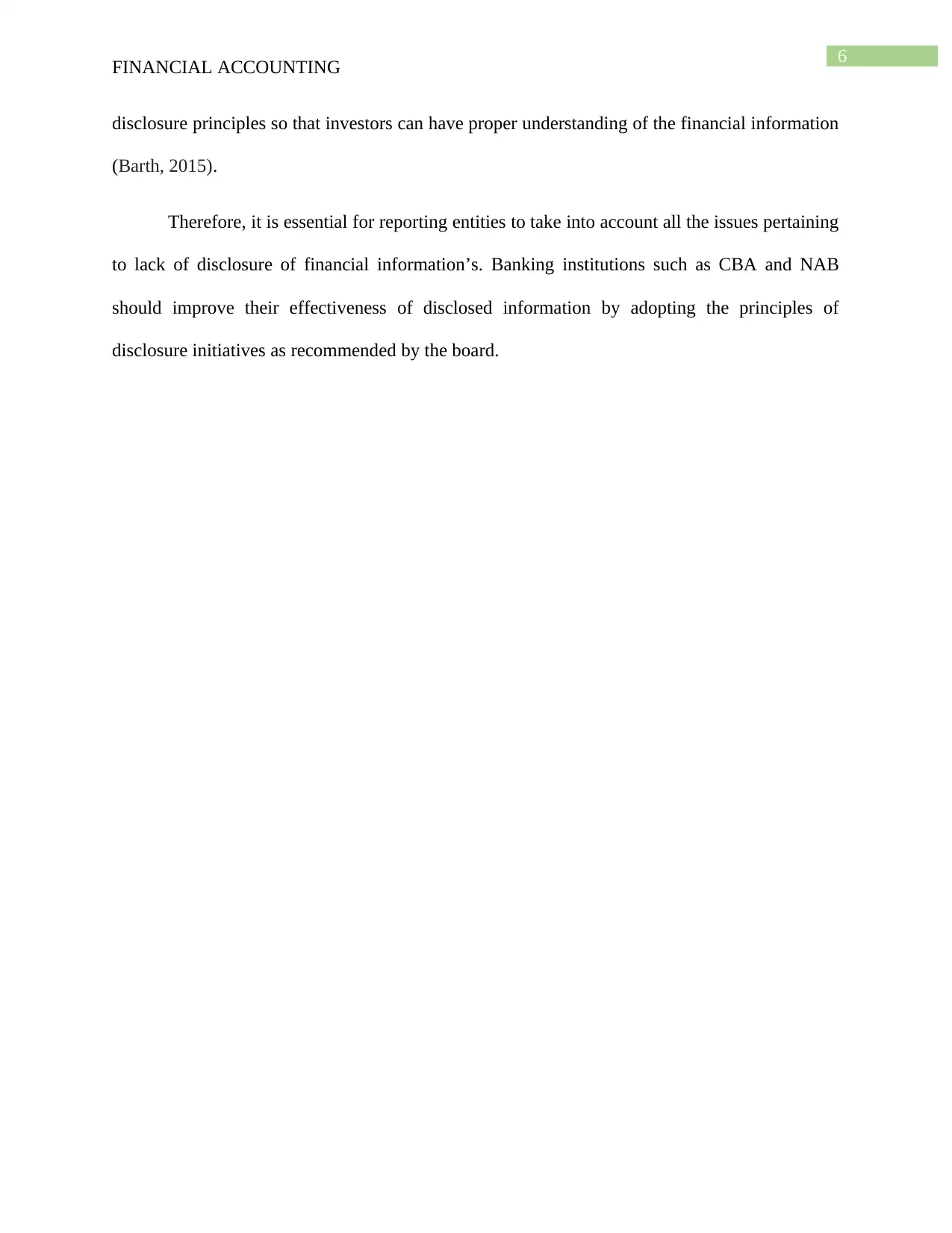
6
FINANCIAL ACCOUNTING
disclosure principles so that investors can have proper understanding of the financial information
(Barth, 2015).
Therefore, it is essential for reporting entities to take into account all the issues pertaining
to lack of disclosure of financial information’s. Banking institutions such as CBA and NAB
should improve their effectiveness of disclosed information by adopting the principles of
disclosure initiatives as recommended by the board.
FINANCIAL ACCOUNTING
disclosure principles so that investors can have proper understanding of the financial information
(Barth, 2015).
Therefore, it is essential for reporting entities to take into account all the issues pertaining
to lack of disclosure of financial information’s. Banking institutions such as CBA and NAB
should improve their effectiveness of disclosed information by adopting the principles of
disclosure initiatives as recommended by the board.
Paraphrase This Document
Need a fresh take? Get an instant paraphrase of this document with our AI Paraphraser
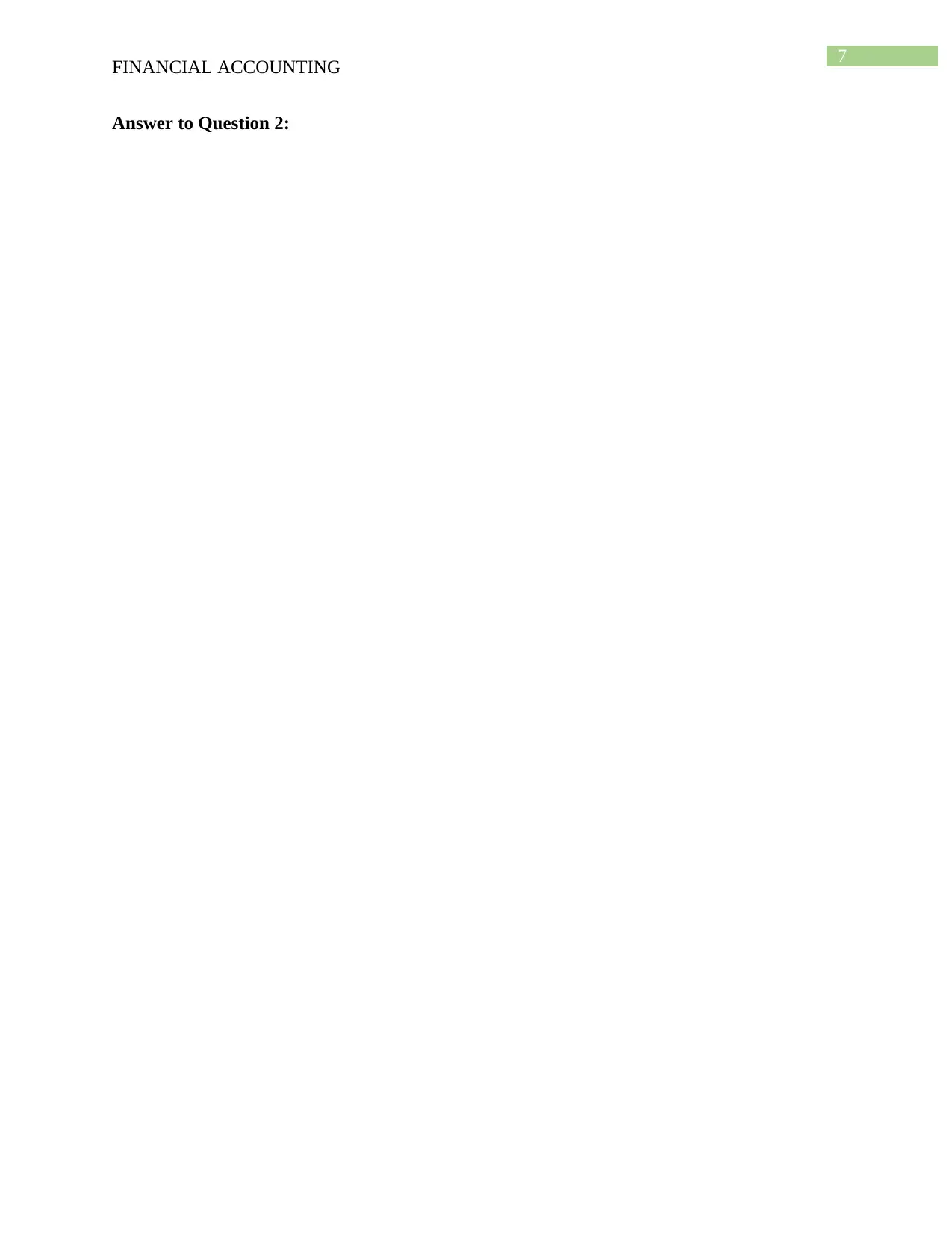
7
FINANCIAL ACCOUNTING
Answer to Question 2:
FINANCIAL ACCOUNTING
Answer to Question 2:
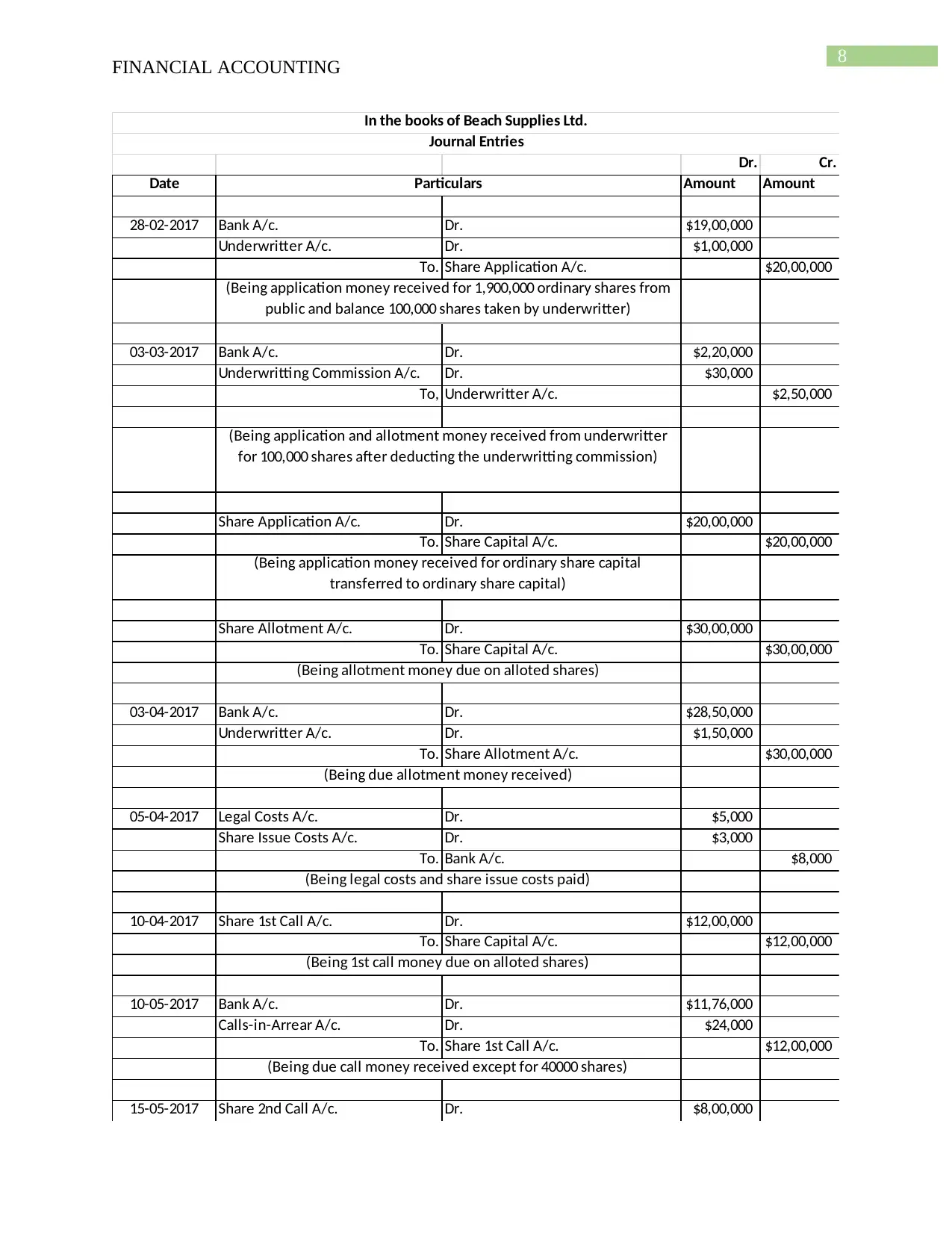
8
FINANCIAL ACCOUNTING
Dr. Cr.
Date Amount Amount
28-02-2017 Bank A/c. Dr. $19,00,000
Underwritter A/c. Dr. $1,00,000
To. Share Application A/c. $20,00,000
03-03-2017 Bank A/c. Dr. $2,20,000
Underwritting Commission A/c. Dr. $30,000
To, Underwritter A/c. $2,50,000
Share Application A/c. Dr. $20,00,000
To. Share Capital A/c. $20,00,000
Share Allotment A/c. Dr. $30,00,000
To. Share Capital A/c. $30,00,000
03-04-2017 Bank A/c. Dr. $28,50,000
Underwritter A/c. Dr. $1,50,000
To. Share Allotment A/c. $30,00,000
05-04-2017 Legal Costs A/c. Dr. $5,000
Share Issue Costs A/c. Dr. $3,000
To. Bank A/c. $8,000
10-04-2017 Share 1st Call A/c. Dr. $12,00,000
To. Share Capital A/c. $12,00,000
10-05-2017 Bank A/c. Dr. $11,76,000
Calls-in-Arrear A/c. Dr. $24,000
To. Share 1st Call A/c. $12,00,000
15-05-2017 Share 2nd Call A/c. Dr. $8,00,000
Particulars
(Being application money received for 1,900,000 ordinary shares from
public and balance 100,000 shares taken by underwritter)
(Being application and allotment money received from underwritter
for 100,000 shares after deducting the underwritting commission)
(Being application money received for ordinary share capital
transferred to ordinary share capital)
(Being allotment money due on alloted shares)
(Being due allotment money received)
(Being 1st call money due on alloted shares)
(Being due call money received except for 40000 shares)
(Being legal costs and share issue costs paid)
In the books of Beach Supplies Ltd.
Journal Entries
FINANCIAL ACCOUNTING
Dr. Cr.
Date Amount Amount
28-02-2017 Bank A/c. Dr. $19,00,000
Underwritter A/c. Dr. $1,00,000
To. Share Application A/c. $20,00,000
03-03-2017 Bank A/c. Dr. $2,20,000
Underwritting Commission A/c. Dr. $30,000
To, Underwritter A/c. $2,50,000
Share Application A/c. Dr. $20,00,000
To. Share Capital A/c. $20,00,000
Share Allotment A/c. Dr. $30,00,000
To. Share Capital A/c. $30,00,000
03-04-2017 Bank A/c. Dr. $28,50,000
Underwritter A/c. Dr. $1,50,000
To. Share Allotment A/c. $30,00,000
05-04-2017 Legal Costs A/c. Dr. $5,000
Share Issue Costs A/c. Dr. $3,000
To. Bank A/c. $8,000
10-04-2017 Share 1st Call A/c. Dr. $12,00,000
To. Share Capital A/c. $12,00,000
10-05-2017 Bank A/c. Dr. $11,76,000
Calls-in-Arrear A/c. Dr. $24,000
To. Share 1st Call A/c. $12,00,000
15-05-2017 Share 2nd Call A/c. Dr. $8,00,000
Particulars
(Being application money received for 1,900,000 ordinary shares from
public and balance 100,000 shares taken by underwritter)
(Being application and allotment money received from underwritter
for 100,000 shares after deducting the underwritting commission)
(Being application money received for ordinary share capital
transferred to ordinary share capital)
(Being allotment money due on alloted shares)
(Being due allotment money received)
(Being 1st call money due on alloted shares)
(Being due call money received except for 40000 shares)
(Being legal costs and share issue costs paid)
In the books of Beach Supplies Ltd.
Journal Entries
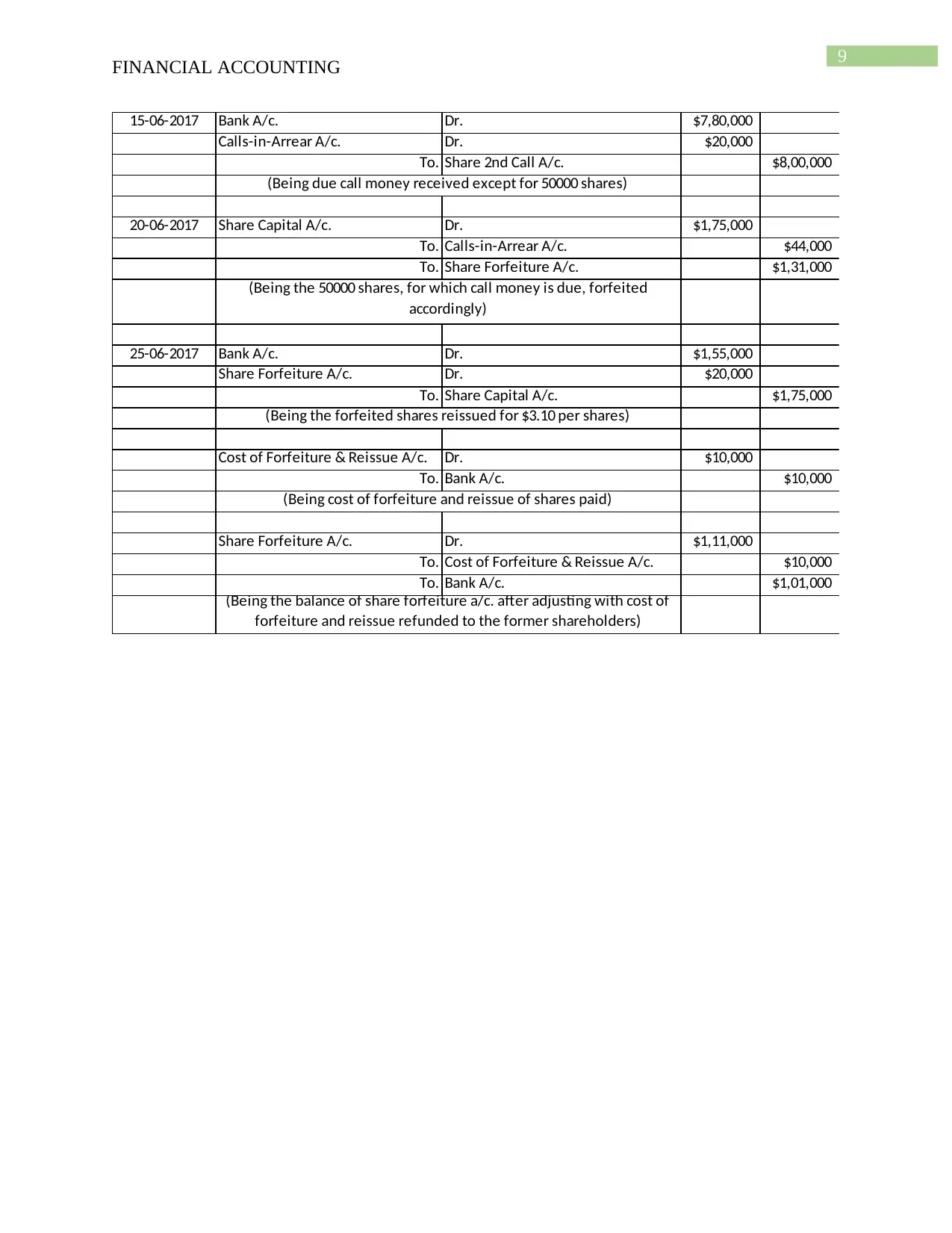
9
FINANCIAL ACCOUNTING
15-06-2017 Bank A/c. Dr. $7,80,000
Calls-in-Arrear A/c. Dr. $20,000
To. Share 2nd Call A/c. $8,00,000
20-06-2017 Share Capital A/c. Dr. $1,75,000
To. Calls-in-Arrear A/c. $44,000
To. Share Forfeiture A/c. $1,31,000
25-06-2017 Bank A/c. Dr. $1,55,000
Share Forfeiture A/c. Dr. $20,000
To. Share Capital A/c. $1,75,000
Cost of Forfeiture & Reissue A/c. Dr. $10,000
To. Bank A/c. $10,000
Share Forfeiture A/c. Dr. $1,11,000
To. Cost of Forfeiture & Reissue A/c. $10,000
To. Bank A/c. $1,01,000
(Being the balance of share forfeiture a/c. after adjusting with cost of
forfeiture and reissue refunded to the former shareholders)
(Being the 50000 shares, for which call money is due, forfeited
accordingly)
(Being the forfeited shares reissued for $3.10 per shares)
(Being cost of forfeiture and reissue of shares paid)
(Being due call money received except for 50000 shares)
FINANCIAL ACCOUNTING
15-06-2017 Bank A/c. Dr. $7,80,000
Calls-in-Arrear A/c. Dr. $20,000
To. Share 2nd Call A/c. $8,00,000
20-06-2017 Share Capital A/c. Dr. $1,75,000
To. Calls-in-Arrear A/c. $44,000
To. Share Forfeiture A/c. $1,31,000
25-06-2017 Bank A/c. Dr. $1,55,000
Share Forfeiture A/c. Dr. $20,000
To. Share Capital A/c. $1,75,000
Cost of Forfeiture & Reissue A/c. Dr. $10,000
To. Bank A/c. $10,000
Share Forfeiture A/c. Dr. $1,11,000
To. Cost of Forfeiture & Reissue A/c. $10,000
To. Bank A/c. $1,01,000
(Being the balance of share forfeiture a/c. after adjusting with cost of
forfeiture and reissue refunded to the former shareholders)
(Being the 50000 shares, for which call money is due, forfeited
accordingly)
(Being the forfeited shares reissued for $3.10 per shares)
(Being cost of forfeiture and reissue of shares paid)
(Being due call money received except for 50000 shares)
Secure Best Marks with AI Grader
Need help grading? Try our AI Grader for instant feedback on your assignments.
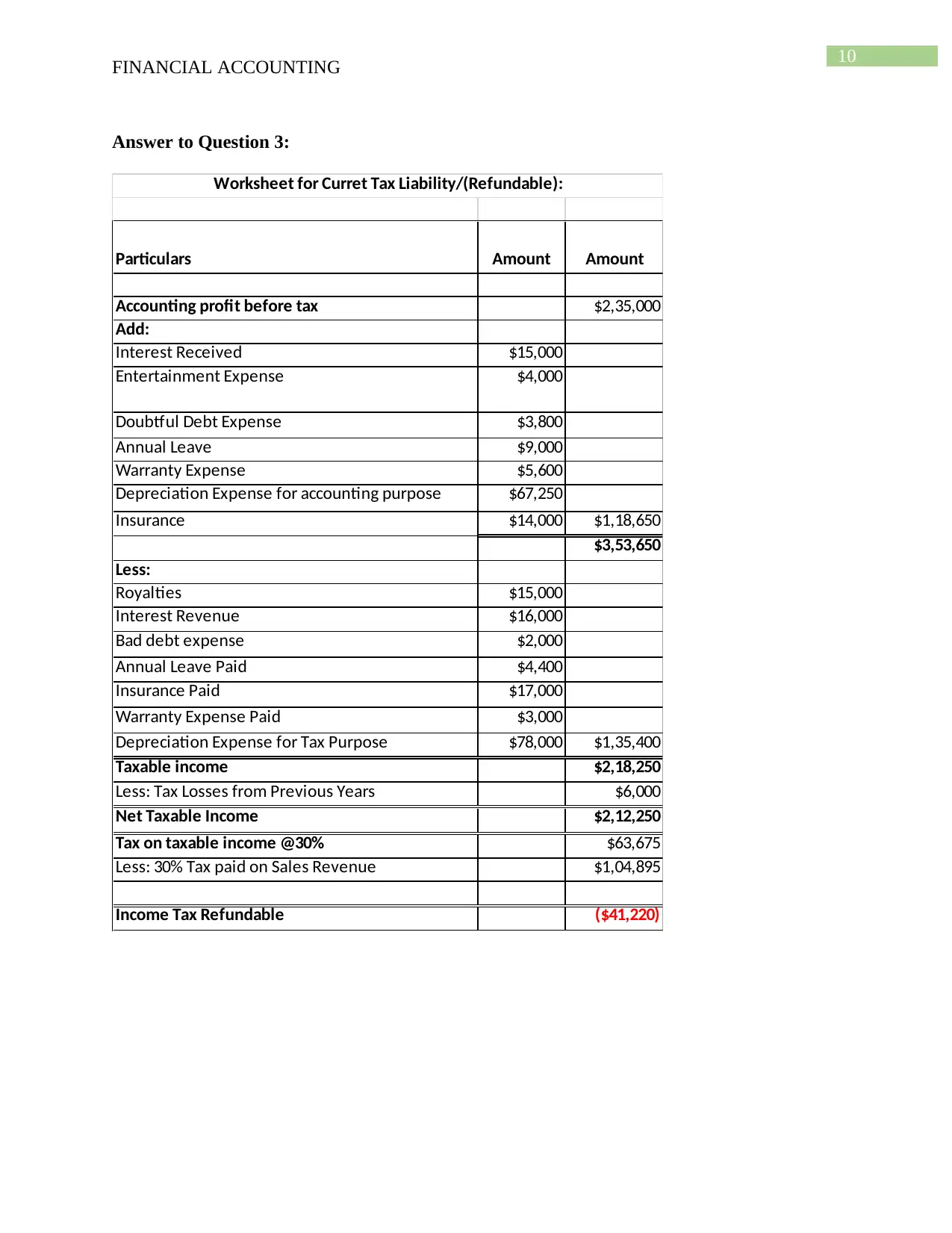
10
FINANCIAL ACCOUNTING
Answer to Question 3:
Particulars Amount Amount
Accounting profit before tax $2,35,000
Add:
Interest Received $15,000
Entertainment Expense $4,000
Doubtful Debt Expense $3,800
Annual Leave $9,000
Warranty Expense $5,600
Depreciation Expense for accounting purpose $67,250
Insurance $14,000 $1,18,650
$3,53,650
Less:
Royalties $15,000
Interest Revenue $16,000
Bad debt expense $2,000
Annual Leave Paid $4,400
Insurance Paid $17,000
Warranty Expense Paid $3,000
Depreciation Expense for Tax Purpose $78,000 $1,35,400
Taxable income $2,18,250
Less: Tax Losses from Previous Years $6,000
Net Taxable Income $2,12,250
Tax on taxable income @30% $63,675
Less: 30% Tax paid on Sales Revenue $1,04,895
Income Tax Refundable ($41,220)
Worksheet for Curret Tax Liability/(Refundable):
FINANCIAL ACCOUNTING
Answer to Question 3:
Particulars Amount Amount
Accounting profit before tax $2,35,000
Add:
Interest Received $15,000
Entertainment Expense $4,000
Doubtful Debt Expense $3,800
Annual Leave $9,000
Warranty Expense $5,600
Depreciation Expense for accounting purpose $67,250
Insurance $14,000 $1,18,650
$3,53,650
Less:
Royalties $15,000
Interest Revenue $16,000
Bad debt expense $2,000
Annual Leave Paid $4,400
Insurance Paid $17,000
Warranty Expense Paid $3,000
Depreciation Expense for Tax Purpose $78,000 $1,35,400
Taxable income $2,18,250
Less: Tax Losses from Previous Years $6,000
Net Taxable Income $2,12,250
Tax on taxable income @30% $63,675
Less: 30% Tax paid on Sales Revenue $1,04,895
Income Tax Refundable ($41,220)
Worksheet for Curret Tax Liability/(Refundable):
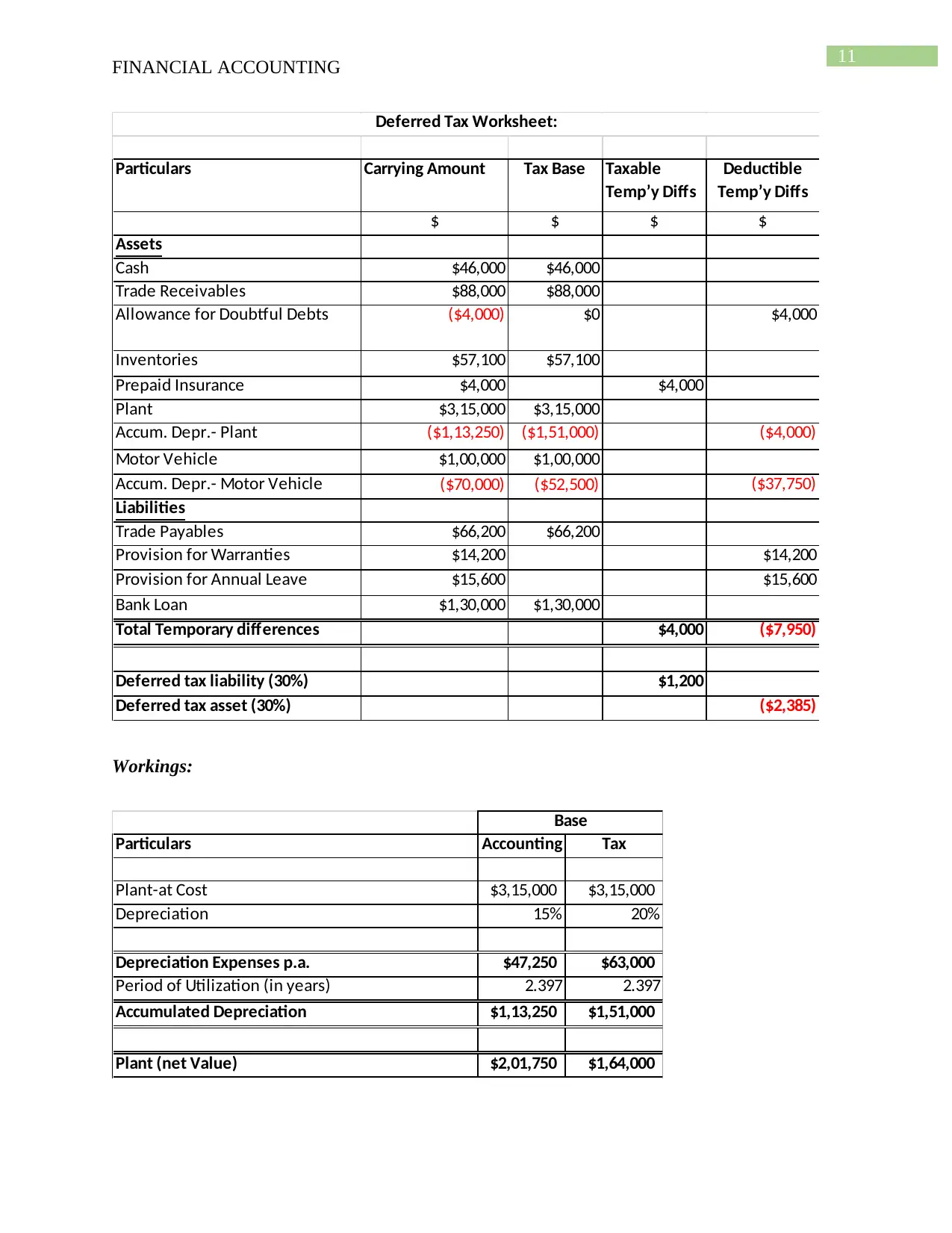
11
FINANCIAL ACCOUNTING
Particulars Carrying Amount Tax Base Taxable
Temp’y Diffs
Deductible
Temp’y Diffs
$ $ $ $
Assets
Cash $46,000 $46,000
Trade Receivables $88,000 $88,000
Allowance for Doubtful Debts ($4,000) $0 $4,000
Inventories $57,100 $57,100
Prepaid Insurance $4,000 $4,000
Plant $3,15,000 $3,15,000
Accum. Depr.- Plant ($1,13,250) ($1,51,000) ($4,000)
Motor Vehicle $1,00,000 $1,00,000
Accum. Depr.- Motor Vehicle ($70,000) ($52,500) ($37,750)
Liabilities
Trade Payables $66,200 $66,200
Provision for Warranties $14,200 $14,200
Provision for Annual Leave $15,600 $15,600
Bank Loan $1,30,000 $1,30,000
Total Temporary differences $4,000 ($7,950)
Deferred tax liability (30%) $1,200
Deferred tax asset (30%) ($2,385)
Deferred Tax Worksheet:
Workings:
Particulars Accounting Tax
Plant-at Cost $3,15,000 $3,15,000
Depreciation 15% 20%
Depreciation Expenses p.a. $47,250 $63,000
Period of Utilization (in years) 2.397 2.397
Accumulated Depreciation $1,13,250 $1,51,000
Plant (net Value) $2,01,750 $1,64,000
Base
FINANCIAL ACCOUNTING
Particulars Carrying Amount Tax Base Taxable
Temp’y Diffs
Deductible
Temp’y Diffs
$ $ $ $
Assets
Cash $46,000 $46,000
Trade Receivables $88,000 $88,000
Allowance for Doubtful Debts ($4,000) $0 $4,000
Inventories $57,100 $57,100
Prepaid Insurance $4,000 $4,000
Plant $3,15,000 $3,15,000
Accum. Depr.- Plant ($1,13,250) ($1,51,000) ($4,000)
Motor Vehicle $1,00,000 $1,00,000
Accum. Depr.- Motor Vehicle ($70,000) ($52,500) ($37,750)
Liabilities
Trade Payables $66,200 $66,200
Provision for Warranties $14,200 $14,200
Provision for Annual Leave $15,600 $15,600
Bank Loan $1,30,000 $1,30,000
Total Temporary differences $4,000 ($7,950)
Deferred tax liability (30%) $1,200
Deferred tax asset (30%) ($2,385)
Deferred Tax Worksheet:
Workings:
Particulars Accounting Tax
Plant-at Cost $3,15,000 $3,15,000
Depreciation 15% 20%
Depreciation Expenses p.a. $47,250 $63,000
Period of Utilization (in years) 2.397 2.397
Accumulated Depreciation $1,13,250 $1,51,000
Plant (net Value) $2,01,750 $1,64,000
Base
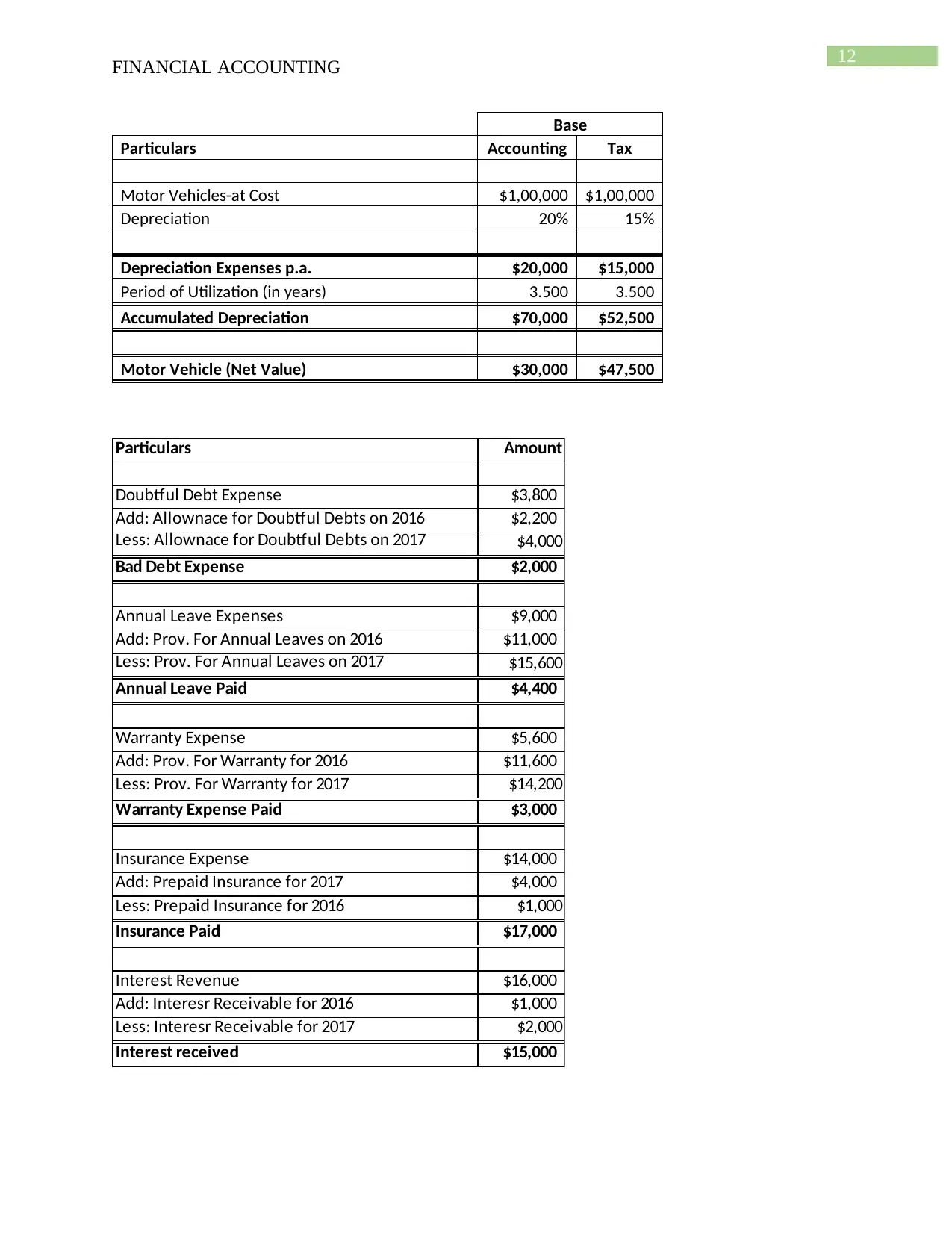
12
FINANCIAL ACCOUNTING
Base
Particulars Accounting Tax
Motor Vehicles-at Cost $1,00,000 $1,00,000
Depreciation 20% 15%
Depreciation Expenses p.a. $20,000 $15,000
Period of Utilization (in years) 3.500 3.500
Accumulated Depreciation $70,000 $52,500
Motor Vehicle (Net Value) $30,000 $47,500
Particulars Amount
Doubtful Debt Expense $3,800
Add: Allownace for Doubtful Debts on 2016 $2,200
Less: Allownace for Doubtful Debts on 2017 $4,000
Bad Debt Expense $2,000
Annual Leave Expenses $9,000
Add: Prov. For Annual Leaves on 2016 $11,000
Less: Prov. For Annual Leaves on 2017 $15,600
Annual Leave Paid $4,400
Warranty Expense $5,600
Add: Prov. For Warranty for 2016 $11,600
Less: Prov. For Warranty for 2017 $14,200
Warranty Expense Paid $3,000
Insurance Expense $14,000
Add: Prepaid Insurance for 2017 $4,000
Less: Prepaid Insurance for 2016 $1,000
Insurance Paid $17,000
Interest Revenue $16,000
Add: Interesr Receivable for 2016 $1,000
Less: Interesr Receivable for 2017 $2,000
Interest received $15,000
FINANCIAL ACCOUNTING
Base
Particulars Accounting Tax
Motor Vehicles-at Cost $1,00,000 $1,00,000
Depreciation 20% 15%
Depreciation Expenses p.a. $20,000 $15,000
Period of Utilization (in years) 3.500 3.500
Accumulated Depreciation $70,000 $52,500
Motor Vehicle (Net Value) $30,000 $47,500
Particulars Amount
Doubtful Debt Expense $3,800
Add: Allownace for Doubtful Debts on 2016 $2,200
Less: Allownace for Doubtful Debts on 2017 $4,000
Bad Debt Expense $2,000
Annual Leave Expenses $9,000
Add: Prov. For Annual Leaves on 2016 $11,000
Less: Prov. For Annual Leaves on 2017 $15,600
Annual Leave Paid $4,400
Warranty Expense $5,600
Add: Prov. For Warranty for 2016 $11,600
Less: Prov. For Warranty for 2017 $14,200
Warranty Expense Paid $3,000
Insurance Expense $14,000
Add: Prepaid Insurance for 2017 $4,000
Less: Prepaid Insurance for 2016 $1,000
Insurance Paid $17,000
Interest Revenue $16,000
Add: Interesr Receivable for 2016 $1,000
Less: Interesr Receivable for 2017 $2,000
Interest received $15,000
Paraphrase This Document
Need a fresh take? Get an instant paraphrase of this document with our AI Paraphraser
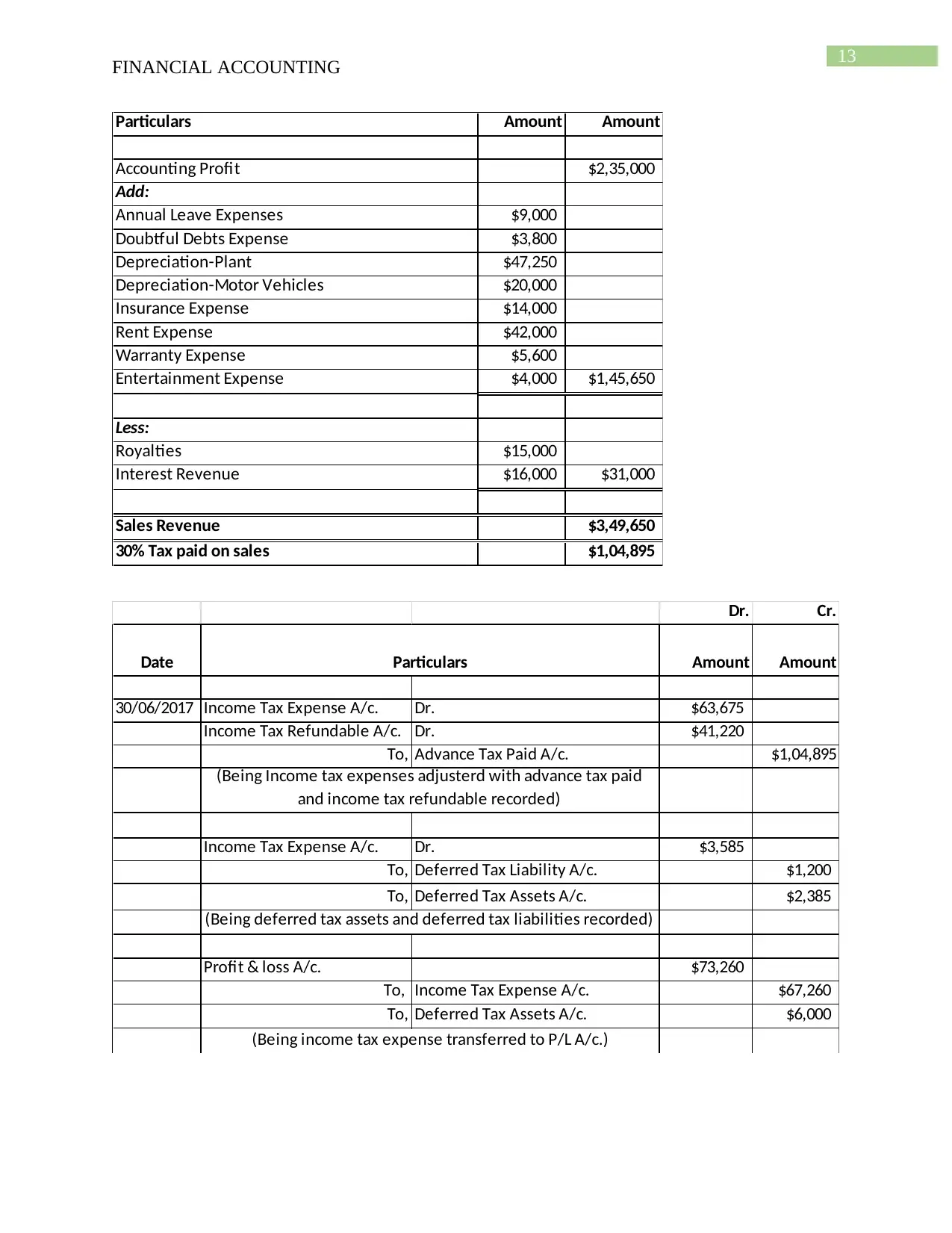
13
FINANCIAL ACCOUNTING
Particulars Amount Amount
Accounting Profit $2,35,000
Add:
Annual Leave Expenses $9,000
Doubtful Debts Expense $3,800
Depreciation-Plant $47,250
Depreciation-Motor Vehicles $20,000
Insurance Expense $14,000
Rent Expense $42,000
Warranty Expense $5,600
Entertainment Expense $4,000 $1,45,650
Less:
Royalties $15,000
Interest Revenue $16,000 $31,000
Sales Revenue $3,49,650
30% Tax paid on sales $1,04,895
Dr. Cr.
Date Amount Amount
30/06/2017 Income Tax Expense A/c. Dr. $63,675
Income Tax Refundable A/c. Dr. $41,220
To, Advance Tax Paid A/c. $1,04,895
Income Tax Expense A/c. Dr. $3,585
To, Deferred Tax Liability A/c. $1,200
To, Deferred Tax Assets A/c. $2,385
Profit & loss A/c. $73,260
To, Income Tax Expense A/c. $67,260
To, Deferred Tax Assets A/c. $6,000
(Being deferred tax assets and deferred tax liabilities recorded)
Particulars
(Being Income tax expenses adjusterd with advance tax paid
and income tax refundable recorded)
(Being income tax expense transferred to P/L A/c.)
FINANCIAL ACCOUNTING
Particulars Amount Amount
Accounting Profit $2,35,000
Add:
Annual Leave Expenses $9,000
Doubtful Debts Expense $3,800
Depreciation-Plant $47,250
Depreciation-Motor Vehicles $20,000
Insurance Expense $14,000
Rent Expense $42,000
Warranty Expense $5,600
Entertainment Expense $4,000 $1,45,650
Less:
Royalties $15,000
Interest Revenue $16,000 $31,000
Sales Revenue $3,49,650
30% Tax paid on sales $1,04,895
Dr. Cr.
Date Amount Amount
30/06/2017 Income Tax Expense A/c. Dr. $63,675
Income Tax Refundable A/c. Dr. $41,220
To, Advance Tax Paid A/c. $1,04,895
Income Tax Expense A/c. Dr. $3,585
To, Deferred Tax Liability A/c. $1,200
To, Deferred Tax Assets A/c. $2,385
Profit & loss A/c. $73,260
To, Income Tax Expense A/c. $67,260
To, Deferred Tax Assets A/c. $6,000
(Being deferred tax assets and deferred tax liabilities recorded)
Particulars
(Being Income tax expenses adjusterd with advance tax paid
and income tax refundable recorded)
(Being income tax expense transferred to P/L A/c.)
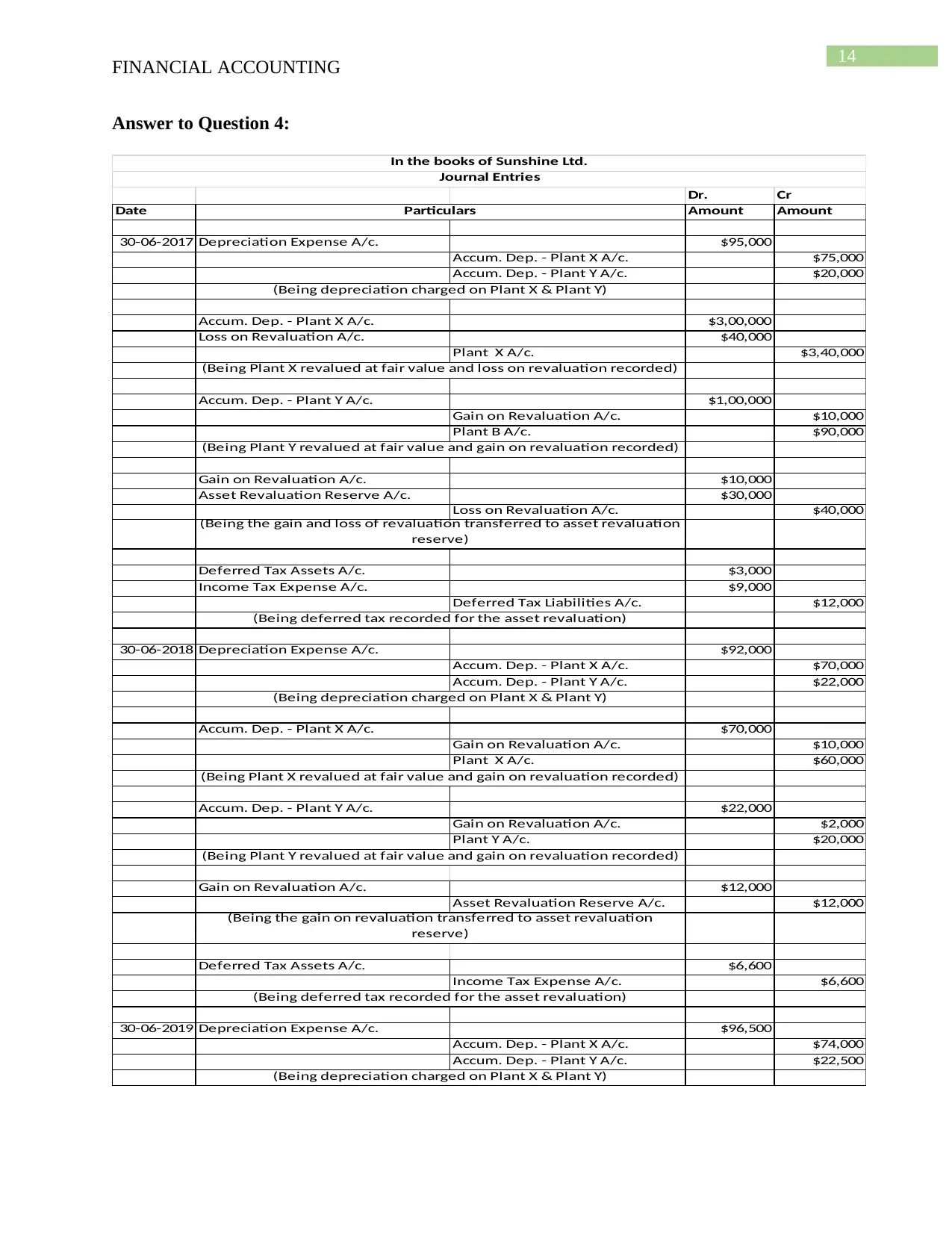
14
FINANCIAL ACCOUNTING
Answer to Question 4:
Dr. Cr
Date Amount Amount
30-06-2017 Depreciation Expense A/c. $95,000
Accum. Dep. - Plant X A/c. $75,000
Accum. Dep. - Plant Y A/c. $20,000
Accum. Dep. - Plant X A/c. $3,00,000
Loss on Revaluation A/c. $40,000
Plant X A/c. $3,40,000
Accum. Dep. - Plant Y A/c. $1,00,000
Gain on Revaluation A/c. $10,000
Plant B A/c. $90,000
Gain on Revaluation A/c. $10,000
Asset Revaluation Reserve A/c. $30,000
Loss on Revaluation A/c. $40,000
Deferred Tax Assets A/c. $3,000
Income Tax Expense A/c. $9,000
Deferred Tax Liabilities A/c. $12,000
30-06-2018 Depreciation Expense A/c. $92,000
Accum. Dep. - Plant X A/c. $70,000
Accum. Dep. - Plant Y A/c. $22,000
Accum. Dep. - Plant X A/c. $70,000
Gain on Revaluation A/c. $10,000
Plant X A/c. $60,000
Accum. Dep. - Plant Y A/c. $22,000
Gain on Revaluation A/c. $2,000
Plant Y A/c. $20,000
Gain on Revaluation A/c. $12,000
Asset Revaluation Reserve A/c. $12,000
Deferred Tax Assets A/c. $6,600
Income Tax Expense A/c. $6,600
30-06-2019 Depreciation Expense A/c. $96,500
Accum. Dep. - Plant X A/c. $74,000
Accum. Dep. - Plant Y A/c. $22,500
(Being depreciation charged on Plant X & Plant Y)
(Being Plant Y revalued at fair value and gain on revaluation recorded)
(Being the gain on revaluation transferred to asset revaluation
reserve)
(Being deferred tax recorded for the asset revaluation)
Journal Entries
(Being deferred tax recorded for the asset revaluation)
(Being depreciation charged on Plant X & Plant Y)
(Being depreciation charged on Plant X & Plant Y)
(Being Plant X revalued at fair value and loss on revaluation recorded)
(Being Plant Y revalued at fair value and gain on revaluation recorded)
(Being the gain and loss of revaluation transferred to asset revaluation
reserve)
(Being Plant X revalued at fair value and gain on revaluation recorded)
Particulars
In the books of Sunshine Ltd.
FINANCIAL ACCOUNTING
Answer to Question 4:
Dr. Cr
Date Amount Amount
30-06-2017 Depreciation Expense A/c. $95,000
Accum. Dep. - Plant X A/c. $75,000
Accum. Dep. - Plant Y A/c. $20,000
Accum. Dep. - Plant X A/c. $3,00,000
Loss on Revaluation A/c. $40,000
Plant X A/c. $3,40,000
Accum. Dep. - Plant Y A/c. $1,00,000
Gain on Revaluation A/c. $10,000
Plant B A/c. $90,000
Gain on Revaluation A/c. $10,000
Asset Revaluation Reserve A/c. $30,000
Loss on Revaluation A/c. $40,000
Deferred Tax Assets A/c. $3,000
Income Tax Expense A/c. $9,000
Deferred Tax Liabilities A/c. $12,000
30-06-2018 Depreciation Expense A/c. $92,000
Accum. Dep. - Plant X A/c. $70,000
Accum. Dep. - Plant Y A/c. $22,000
Accum. Dep. - Plant X A/c. $70,000
Gain on Revaluation A/c. $10,000
Plant X A/c. $60,000
Accum. Dep. - Plant Y A/c. $22,000
Gain on Revaluation A/c. $2,000
Plant Y A/c. $20,000
Gain on Revaluation A/c. $12,000
Asset Revaluation Reserve A/c. $12,000
Deferred Tax Assets A/c. $6,600
Income Tax Expense A/c. $6,600
30-06-2019 Depreciation Expense A/c. $96,500
Accum. Dep. - Plant X A/c. $74,000
Accum. Dep. - Plant Y A/c. $22,500
(Being depreciation charged on Plant X & Plant Y)
(Being Plant Y revalued at fair value and gain on revaluation recorded)
(Being the gain on revaluation transferred to asset revaluation
reserve)
(Being deferred tax recorded for the asset revaluation)
Journal Entries
(Being deferred tax recorded for the asset revaluation)
(Being depreciation charged on Plant X & Plant Y)
(Being depreciation charged on Plant X & Plant Y)
(Being Plant X revalued at fair value and loss on revaluation recorded)
(Being Plant Y revalued at fair value and gain on revaluation recorded)
(Being the gain and loss of revaluation transferred to asset revaluation
reserve)
(Being Plant X revalued at fair value and gain on revaluation recorded)
Particulars
In the books of Sunshine Ltd.
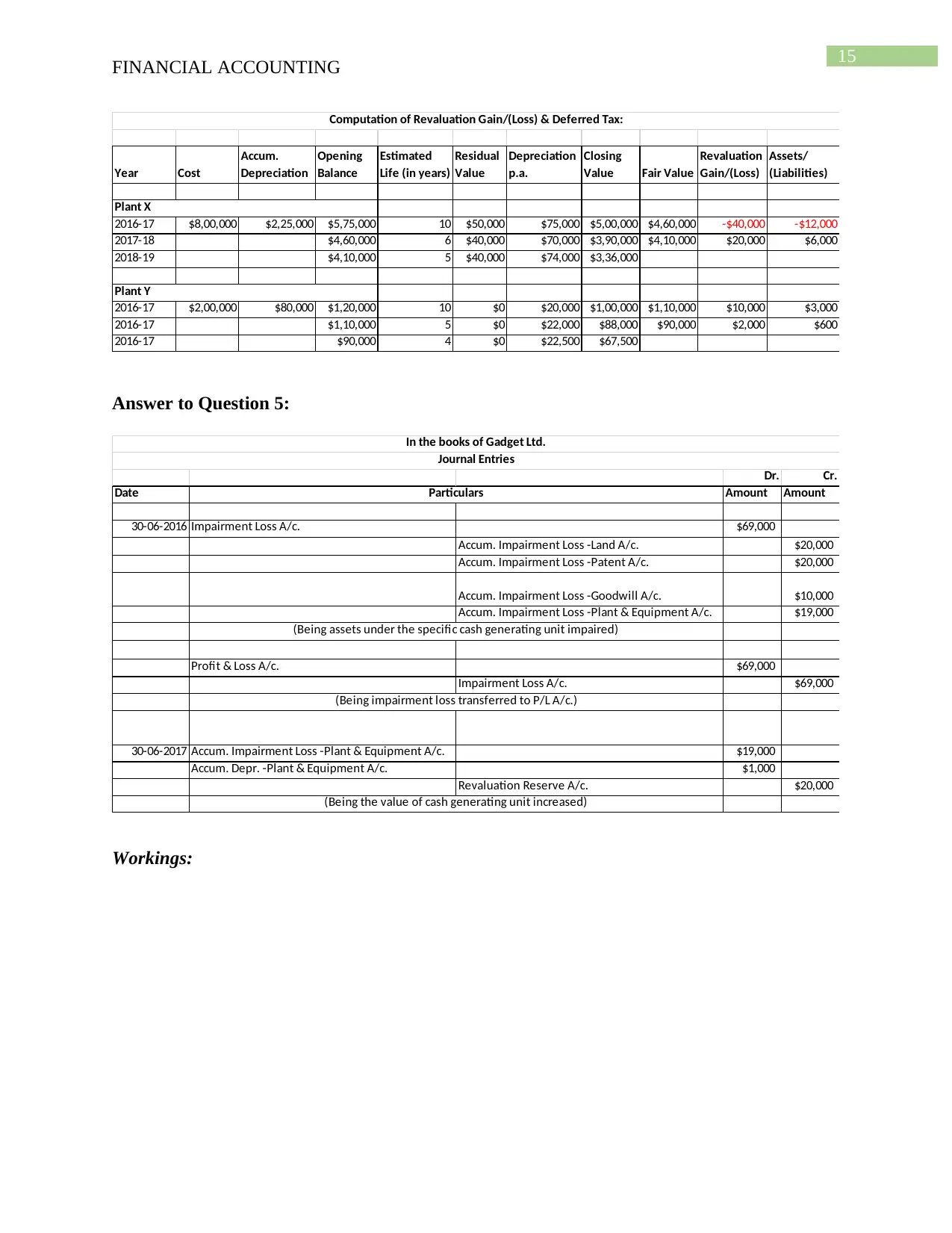
15
FINANCIAL ACCOUNTING
Year Cost
Accum.
Depreciation
Opening
Balance
Estimated
Life (in years)
Residual
Value
Depreciation
p.a.
Closing
Value Fair Value
Revaluation
Gain/(Loss)
Deferred Tax
Assets/
(Liabilities)
2016-17 $8,00,000 $2,25,000 $5,75,000 10 $50,000 $75,000 $5,00,000 $4,60,000 -$40,000 -$12,000
2017-18 $4,60,000 6 $40,000 $70,000 $3,90,000 $4,10,000 $20,000 $6,000
2018-19 $4,10,000 5 $40,000 $74,000 $3,36,000
2016-17 $2,00,000 $80,000 $1,20,000 10 $0 $20,000 $1,00,000 $1,10,000 $10,000 $3,000
2016-17 $1,10,000 5 $0 $22,000 $88,000 $90,000 $2,000 $600
2016-17 $90,000 4 $0 $22,500 $67,500
Plant X
Plant Y
Computation of Revaluation Gain/(Loss) & Deferred Tax:
Answer to Question 5:
Dr. Cr.
Date Amount Amount
30-06-2016 Impairment Loss A/c. $69,000
Accum. Impairment Loss -Land A/c. $20,000
Accum. Impairment Loss -Patent A/c. $20,000
Accum. Impairment Loss -Goodwill A/c. $10,000
Accum. Impairment Loss -Plant & Equipment A/c. $19,000
Profit & Loss A/c. $69,000
Impairment Loss A/c. $69,000
30-06-2017 Accum. Impairment Loss -Plant & Equipment A/c. $19,000
Accum. Depr. -Plant & Equipment A/c. $1,000
Revaluation Reserve A/c. $20,000
In the books of Gadget Ltd.
Journal Entries
Particulars
(Being assets under the specific cash generating unit impaired)
(Being impairment loss transferred to P/L A/c.)
(Being the value of cash generating unit increased)
Workings:
FINANCIAL ACCOUNTING
Year Cost
Accum.
Depreciation
Opening
Balance
Estimated
Life (in years)
Residual
Value
Depreciation
p.a.
Closing
Value Fair Value
Revaluation
Gain/(Loss)
Deferred Tax
Assets/
(Liabilities)
2016-17 $8,00,000 $2,25,000 $5,75,000 10 $50,000 $75,000 $5,00,000 $4,60,000 -$40,000 -$12,000
2017-18 $4,60,000 6 $40,000 $70,000 $3,90,000 $4,10,000 $20,000 $6,000
2018-19 $4,10,000 5 $40,000 $74,000 $3,36,000
2016-17 $2,00,000 $80,000 $1,20,000 10 $0 $20,000 $1,00,000 $1,10,000 $10,000 $3,000
2016-17 $1,10,000 5 $0 $22,000 $88,000 $90,000 $2,000 $600
2016-17 $90,000 4 $0 $22,500 $67,500
Plant X
Plant Y
Computation of Revaluation Gain/(Loss) & Deferred Tax:
Answer to Question 5:
Dr. Cr.
Date Amount Amount
30-06-2016 Impairment Loss A/c. $69,000
Accum. Impairment Loss -Land A/c. $20,000
Accum. Impairment Loss -Patent A/c. $20,000
Accum. Impairment Loss -Goodwill A/c. $10,000
Accum. Impairment Loss -Plant & Equipment A/c. $19,000
Profit & Loss A/c. $69,000
Impairment Loss A/c. $69,000
30-06-2017 Accum. Impairment Loss -Plant & Equipment A/c. $19,000
Accum. Depr. -Plant & Equipment A/c. $1,000
Revaluation Reserve A/c. $20,000
In the books of Gadget Ltd.
Journal Entries
Particulars
(Being assets under the specific cash generating unit impaired)
(Being impairment loss transferred to P/L A/c.)
(Being the value of cash generating unit increased)
Workings:
Secure Best Marks with AI Grader
Need help grading? Try our AI Grader for instant feedback on your assignments.
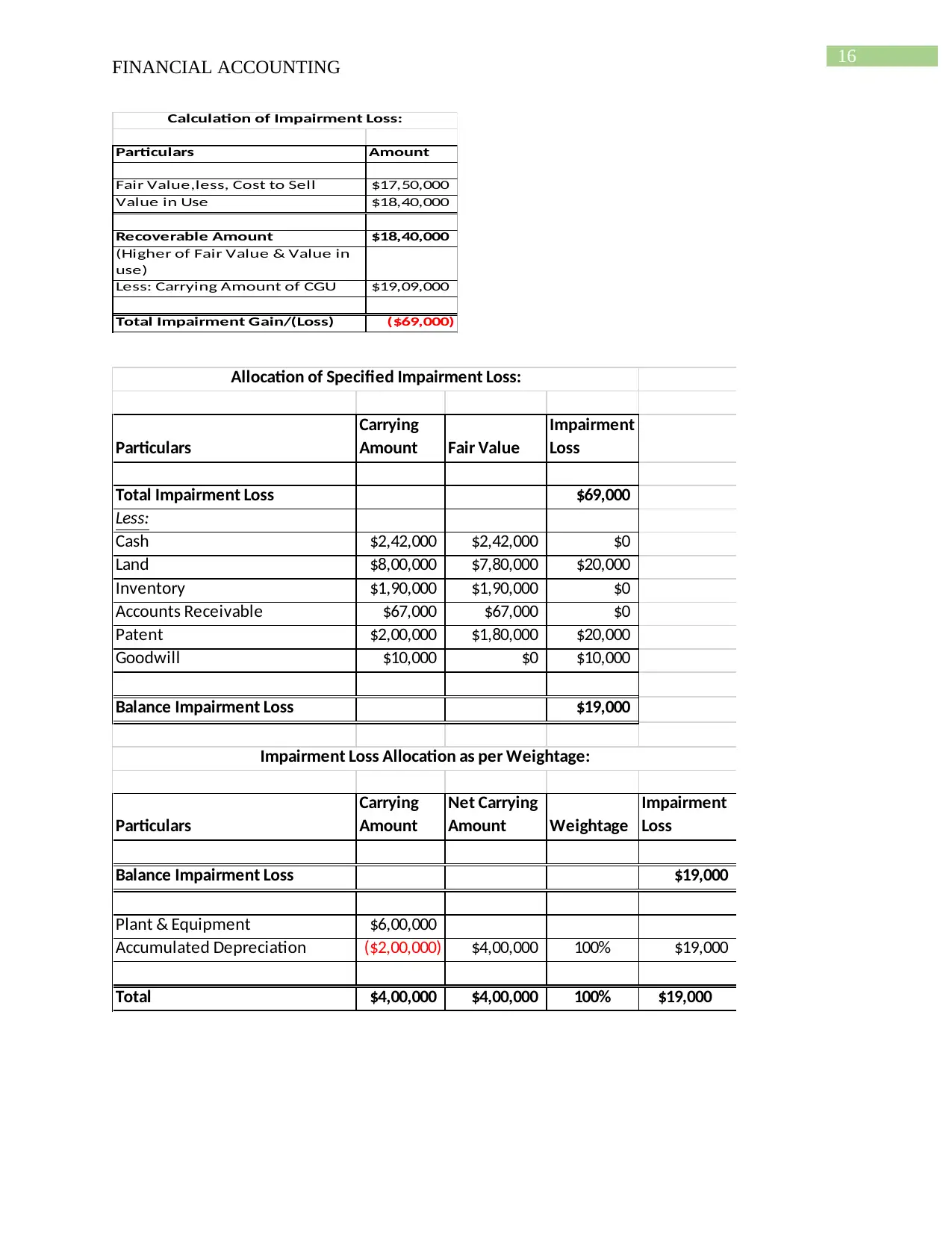
16
FINANCIAL ACCOUNTING
Particulars Amount
Fair Value,less, Cost to Sell $17,50,000
Value in Use $18,40,000
Recoverable Amount $18,40,000
(Higher of Fair Value & Value in
use)
Less: Carrying Amount of CGU $19,09,000
Total Impairment Gain/(Loss) ($69,000)
Calculation of Impairment Loss:
Particulars
Carrying
Amount Fair Value
Impairment
Loss
Total Impairment Loss $69,000
Less:
Cash $2,42,000 $2,42,000 $0
Land $8,00,000 $7,80,000 $20,000
Inventory $1,90,000 $1,90,000 $0
Accounts Receivable $67,000 $67,000 $0
Patent $2,00,000 $1,80,000 $20,000
Goodwill $10,000 $0 $10,000
Balance Impairment Loss $19,000
Particulars
Carrying
Amount
Net Carrying
Amount Weightage
Impairment
Loss
Balance Impairment Loss $19,000
Plant & Equipment $6,00,000
Accumulated Depreciation ($2,00,000) $4,00,000 100% $19,000
Total $4,00,000 $4,00,000 100% $19,000
Impairment Loss Allocation as per Weightage:
Allocation of Specified Impairment Loss:
FINANCIAL ACCOUNTING
Particulars Amount
Fair Value,less, Cost to Sell $17,50,000
Value in Use $18,40,000
Recoverable Amount $18,40,000
(Higher of Fair Value & Value in
use)
Less: Carrying Amount of CGU $19,09,000
Total Impairment Gain/(Loss) ($69,000)
Calculation of Impairment Loss:
Particulars
Carrying
Amount Fair Value
Impairment
Loss
Total Impairment Loss $69,000
Less:
Cash $2,42,000 $2,42,000 $0
Land $8,00,000 $7,80,000 $20,000
Inventory $1,90,000 $1,90,000 $0
Accounts Receivable $67,000 $67,000 $0
Patent $2,00,000 $1,80,000 $20,000
Goodwill $10,000 $0 $10,000
Balance Impairment Loss $19,000
Particulars
Carrying
Amount
Net Carrying
Amount Weightage
Impairment
Loss
Balance Impairment Loss $19,000
Plant & Equipment $6,00,000
Accumulated Depreciation ($2,00,000) $4,00,000 100% $19,000
Total $4,00,000 $4,00,000 100% $19,000
Impairment Loss Allocation as per Weightage:
Allocation of Specified Impairment Loss:
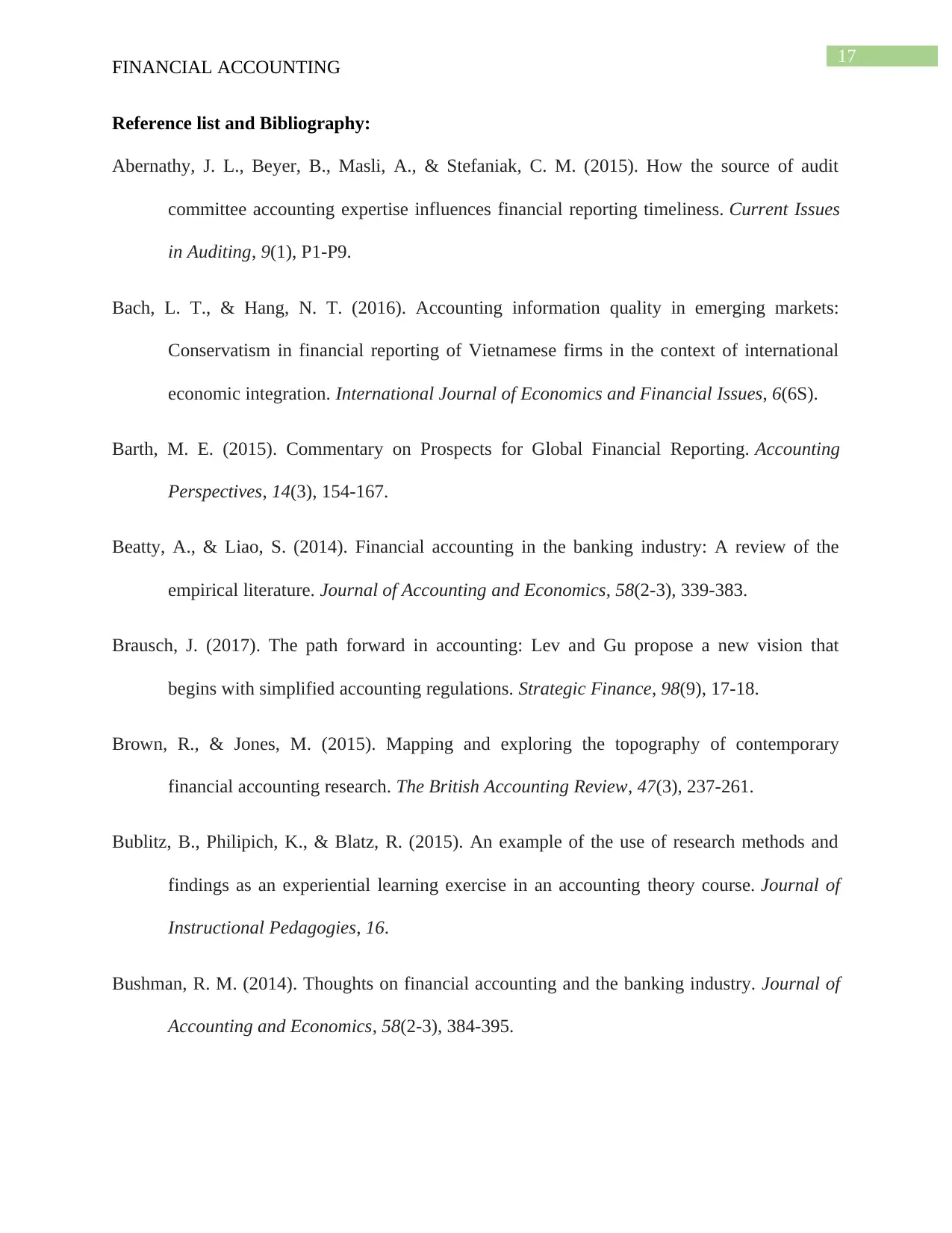
17
FINANCIAL ACCOUNTING
Reference list and Bibliography:
Abernathy, J. L., Beyer, B., Masli, A., & Stefaniak, C. M. (2015). How the source of audit
committee accounting expertise influences financial reporting timeliness. Current Issues
in Auditing, 9(1), P1-P9.
Bach, L. T., & Hang, N. T. (2016). Accounting information quality in emerging markets:
Conservatism in financial reporting of Vietnamese firms in the context of international
economic integration. International Journal of Economics and Financial Issues, 6(6S).
Barth, M. E. (2015). Commentary on Prospects for Global Financial Reporting. Accounting
Perspectives, 14(3), 154-167.
Beatty, A., & Liao, S. (2014). Financial accounting in the banking industry: A review of the
empirical literature. Journal of Accounting and Economics, 58(2-3), 339-383.
Brausch, J. (2017). The path forward in accounting: Lev and Gu propose a new vision that
begins with simplified accounting regulations. Strategic Finance, 98(9), 17-18.
Brown, R., & Jones, M. (2015). Mapping and exploring the topography of contemporary
financial accounting research. The British Accounting Review, 47(3), 237-261.
Bublitz, B., Philipich, K., & Blatz, R. (2015). An example of the use of research methods and
findings as an experiential learning exercise in an accounting theory course. Journal of
Instructional Pedagogies, 16.
Bushman, R. M. (2014). Thoughts on financial accounting and the banking industry. Journal of
Accounting and Economics, 58(2-3), 384-395.
FINANCIAL ACCOUNTING
Reference list and Bibliography:
Abernathy, J. L., Beyer, B., Masli, A., & Stefaniak, C. M. (2015). How the source of audit
committee accounting expertise influences financial reporting timeliness. Current Issues
in Auditing, 9(1), P1-P9.
Bach, L. T., & Hang, N. T. (2016). Accounting information quality in emerging markets:
Conservatism in financial reporting of Vietnamese firms in the context of international
economic integration. International Journal of Economics and Financial Issues, 6(6S).
Barth, M. E. (2015). Commentary on Prospects for Global Financial Reporting. Accounting
Perspectives, 14(3), 154-167.
Beatty, A., & Liao, S. (2014). Financial accounting in the banking industry: A review of the
empirical literature. Journal of Accounting and Economics, 58(2-3), 339-383.
Brausch, J. (2017). The path forward in accounting: Lev and Gu propose a new vision that
begins with simplified accounting regulations. Strategic Finance, 98(9), 17-18.
Brown, R., & Jones, M. (2015). Mapping and exploring the topography of contemporary
financial accounting research. The British Accounting Review, 47(3), 237-261.
Bublitz, B., Philipich, K., & Blatz, R. (2015). An example of the use of research methods and
findings as an experiential learning exercise in an accounting theory course. Journal of
Instructional Pedagogies, 16.
Bushman, R. M. (2014). Thoughts on financial accounting and the banking industry. Journal of
Accounting and Economics, 58(2-3), 384-395.

18
FINANCIAL ACCOUNTING
Caria, A. A., & Rodrigues, L. L. (2014). The evolution of financial accounting in Portugal since
the 1960s: A new institutional economics perspective. Accounting History, 19(1-2), 227-
254.
Crawley, M., & Wahlen, J. (2014). Analytics in empirical/archival financial accounting
research. Business Horizons, 57(5), 583-593.
Dutta, S., & Patatoukas, P. N. (2016). Identifying Conditional Conservatism in Financial
Accounting Data: Theory and Evidence. The Accounting Review, 92(4), 191-216.
Henderson, S., Peirson, G., Herbohn, K., & Howieson, B. (2015). Issues in financial accounting.
Pearson Higher Education AU.
Hoggett, J., Edwards, L., Medlin, J., Chalmers, K., Hellmann, A., Beattie, C., & Maxfield, J.
(2014). Financial accounting.
Horton, J. (2018). Advanced Financial Accounting and Reporting: Theory, Practice and
Evidence. Routledge.
Jiang, J., Wang, I. Y., & Xie, Y. (2015). Does it matter who serves on the Financial Accounting
Standards Board? Bob Herz’s resignation and fair value accounting for loans. Review of
Accounting Studies, 20(1), 371-394.
Klychova, G. S., Fakhretdinova, E. N., Klychova, A. S., & Antonova, N. V. (2015).
Development of accounting and financial reporting for small and medium-sized
businesses in accordance with international financial reporting standards. Asian Social
Science, 11(11), 318.
FINANCIAL ACCOUNTING
Caria, A. A., & Rodrigues, L. L. (2014). The evolution of financial accounting in Portugal since
the 1960s: A new institutional economics perspective. Accounting History, 19(1-2), 227-
254.
Crawley, M., & Wahlen, J. (2014). Analytics in empirical/archival financial accounting
research. Business Horizons, 57(5), 583-593.
Dutta, S., & Patatoukas, P. N. (2016). Identifying Conditional Conservatism in Financial
Accounting Data: Theory and Evidence. The Accounting Review, 92(4), 191-216.
Henderson, S., Peirson, G., Herbohn, K., & Howieson, B. (2015). Issues in financial accounting.
Pearson Higher Education AU.
Hoggett, J., Edwards, L., Medlin, J., Chalmers, K., Hellmann, A., Beattie, C., & Maxfield, J.
(2014). Financial accounting.
Horton, J. (2018). Advanced Financial Accounting and Reporting: Theory, Practice and
Evidence. Routledge.
Jiang, J., Wang, I. Y., & Xie, Y. (2015). Does it matter who serves on the Financial Accounting
Standards Board? Bob Herz’s resignation and fair value accounting for loans. Review of
Accounting Studies, 20(1), 371-394.
Klychova, G. S., Fakhretdinova, E. N., Klychova, A. S., & Antonova, N. V. (2015).
Development of accounting and financial reporting for small and medium-sized
businesses in accordance with international financial reporting standards. Asian Social
Science, 11(11), 318.
Paraphrase This Document
Need a fresh take? Get an instant paraphrase of this document with our AI Paraphraser
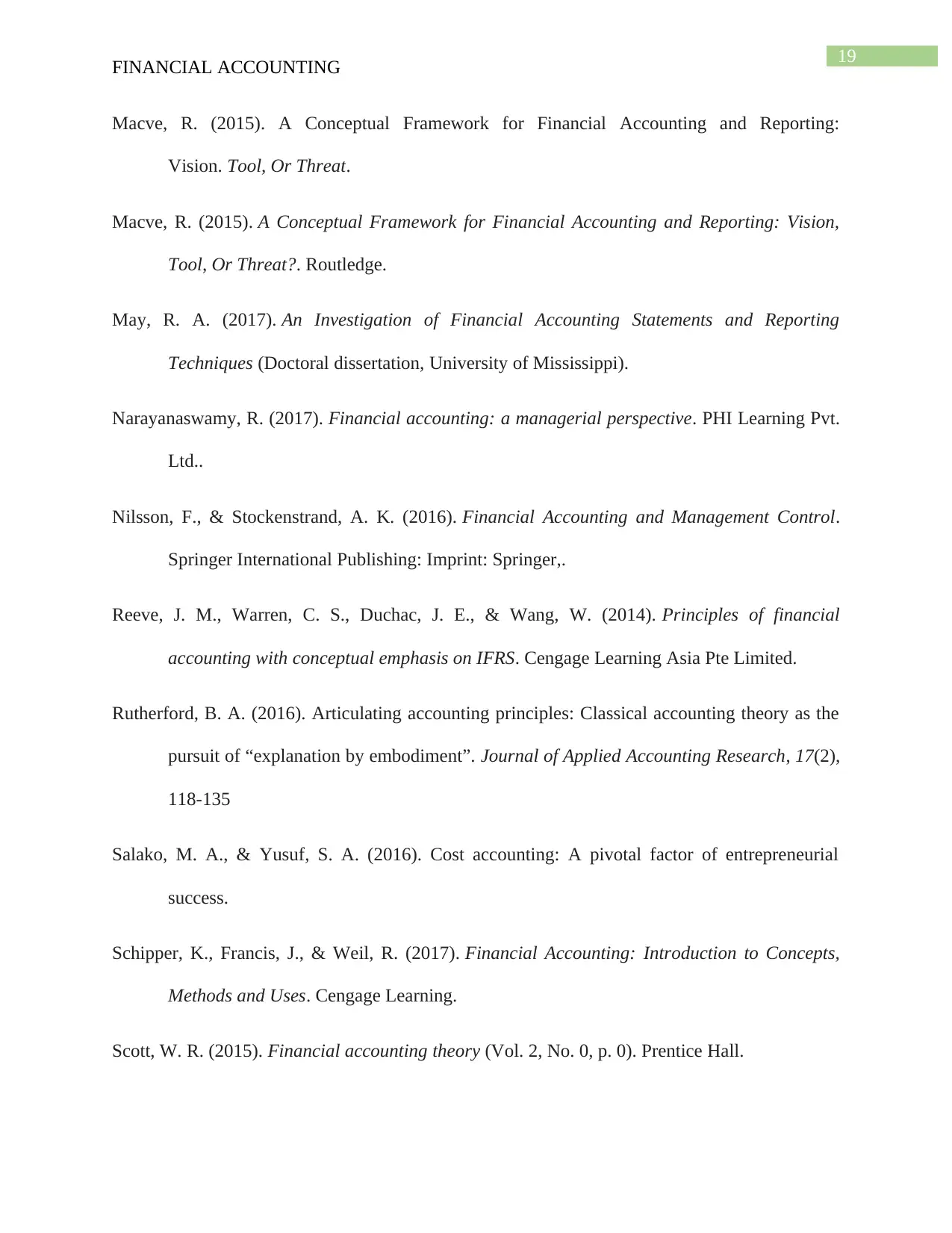
19
FINANCIAL ACCOUNTING
Macve, R. (2015). A Conceptual Framework for Financial Accounting and Reporting:
Vision. Tool, Or Threat.
Macve, R. (2015). A Conceptual Framework for Financial Accounting and Reporting: Vision,
Tool, Or Threat?. Routledge.
May, R. A. (2017). An Investigation of Financial Accounting Statements and Reporting
Techniques (Doctoral dissertation, University of Mississippi).
Narayanaswamy, R. (2017). Financial accounting: a managerial perspective. PHI Learning Pvt.
Ltd..
Nilsson, F., & Stockenstrand, A. K. (2016). Financial Accounting and Management Control.
Springer International Publishing: Imprint: Springer,.
Reeve, J. M., Warren, C. S., Duchac, J. E., & Wang, W. (2014). Principles of financial
accounting with conceptual emphasis on IFRS. Cengage Learning Asia Pte Limited.
Rutherford, B. A. (2016). Articulating accounting principles: Classical accounting theory as the
pursuit of “explanation by embodiment”. Journal of Applied Accounting Research, 17(2),
118-135
Salako, M. A., & Yusuf, S. A. (2016). Cost accounting: A pivotal factor of entrepreneurial
success.
Schipper, K., Francis, J., & Weil, R. (2017). Financial Accounting: Introduction to Concepts,
Methods and Uses. Cengage Learning.
Scott, W. R. (2015). Financial accounting theory (Vol. 2, No. 0, p. 0). Prentice Hall.
FINANCIAL ACCOUNTING
Macve, R. (2015). A Conceptual Framework for Financial Accounting and Reporting:
Vision. Tool, Or Threat.
Macve, R. (2015). A Conceptual Framework for Financial Accounting and Reporting: Vision,
Tool, Or Threat?. Routledge.
May, R. A. (2017). An Investigation of Financial Accounting Statements and Reporting
Techniques (Doctoral dissertation, University of Mississippi).
Narayanaswamy, R. (2017). Financial accounting: a managerial perspective. PHI Learning Pvt.
Ltd..
Nilsson, F., & Stockenstrand, A. K. (2016). Financial Accounting and Management Control.
Springer International Publishing: Imprint: Springer,.
Reeve, J. M., Warren, C. S., Duchac, J. E., & Wang, W. (2014). Principles of financial
accounting with conceptual emphasis on IFRS. Cengage Learning Asia Pte Limited.
Rutherford, B. A. (2016). Articulating accounting principles: Classical accounting theory as the
pursuit of “explanation by embodiment”. Journal of Applied Accounting Research, 17(2),
118-135
Salako, M. A., & Yusuf, S. A. (2016). Cost accounting: A pivotal factor of entrepreneurial
success.
Schipper, K., Francis, J., & Weil, R. (2017). Financial Accounting: Introduction to Concepts,
Methods and Uses. Cengage Learning.
Scott, W. R. (2015). Financial accounting theory (Vol. 2, No. 0, p. 0). Prentice Hall.

20
FINANCIAL ACCOUNTING
Trucco, S. (2015). Premises for the Convergence of Financial Accounting and Management
Accounting. In Financial Accounting (pp. 41-64). Springer, Cham.
Tschopp, D., & Huefner, R. J. (2015). Comparing the Evolution of CSR Reporting to that of
Financial Reporting. Journal of Business Ethics, 127(3), 565-577.
Warren, C. S., & Jones, J. (2018). Corporate financial accounting. Cengage Learning.
Wild, J. (2015). Financial accounting fundamentals. McGraw-Hill Higher Education.
FINANCIAL ACCOUNTING
Trucco, S. (2015). Premises for the Convergence of Financial Accounting and Management
Accounting. In Financial Accounting (pp. 41-64). Springer, Cham.
Tschopp, D., & Huefner, R. J. (2015). Comparing the Evolution of CSR Reporting to that of
Financial Reporting. Journal of Business Ethics, 127(3), 565-577.
Warren, C. S., & Jones, J. (2018). Corporate financial accounting. Cengage Learning.
Wild, J. (2015). Financial accounting fundamentals. McGraw-Hill Higher Education.
1 out of 21
Related Documents
Your All-in-One AI-Powered Toolkit for Academic Success.
+13062052269
info@desklib.com
Available 24*7 on WhatsApp / Email
![[object Object]](/_next/static/media/star-bottom.7253800d.svg)
Unlock your academic potential
© 2024 | Zucol Services PVT LTD | All rights reserved.




